Casper Rouchmann, is currently the Head of Marketing at United Fintech, at the time of writing this he was Head of Growth at Templafy.
In this article, I’ll talk about the most pressing thing to have right now, a growth mindset. Every man and his dog think they do growth, and while some of it might be true, I consistently see the same mistakes made time and time again.
Hacks are not the solution, the process is and there’s no silver bullet when it comes to growth. A laser-sharp focus on the right metrics is critical, and I’ll discuss what they look like and share a case study from my time at Templafy as well as four key lessons I wish I’d been taught about growth.
My name’s Casper Rouchmann and I’m Head of Growth at Templafy, a template management solution from Copenhagen. I've been here for almost three years now.
I used to handle all our social media presence paid-wise; paid acquisition, LinkedIn, Facebook, Google ads, all that stuff. I like to call myself a self-declared expert on paid advertising and think I still am.
I'm a huge nerd, I love inbound marketing, superheroes, eSports, chess, all that stuff. Whenever there's strategy and nerdery then I'm part of it. I also love to use emojis and you'll notice that throughout this article.
The agenda
- I'll give you an introduction to provide context and make sure everyone's on the same level.
- I'll talk about metrics that actually matter as I feel this is a topic that’s not covered enough, and not covered in the right way.
- Then I'm going to share a case of some of the stuff I've done at Templafy to further prove the points I make.
- Lastly, I'll finish with a lightning round to make sure everyone understands some of my findings.
Of course, there's a disclaimer. There's a bunch of stuff I can't cover, I would love to cover more about the process and maybe I'll do that in a future article. In this article, I want to talk more about the mindset and give you some of the most important things you want to be thinking about when you're starting your growth journey.
The goal
Lastly, the goal for today is simple, I want to share things that I would love for someone to have told me when I started out doing these things. If somebody had told me some of the things I'm showing you, I probably wouldn't have made as many mistakes.
My growth journey
I’m 29 years old, nearly 30, and my growth journey started about 10 years ago. I used to work in sales and I used to be a phone salesman back home when we were still selling newspapers through the phone.
Sales for seven years
I did that for seven years. I was working cold calls and did my whole journey there. That was super useful. Why? Because it gets you into the right mindset.
Working phone calls, doing cold calls, and being like a salesman in general, full transparency, was the roughest part of sales you could be in. This was hardcore cold calling. There's no cheeky mama helping you out here. This was hardcore.
I did that for seven years and I tracked and did a little test and found that I called and spoke with almost 100,000 people in Denmark.
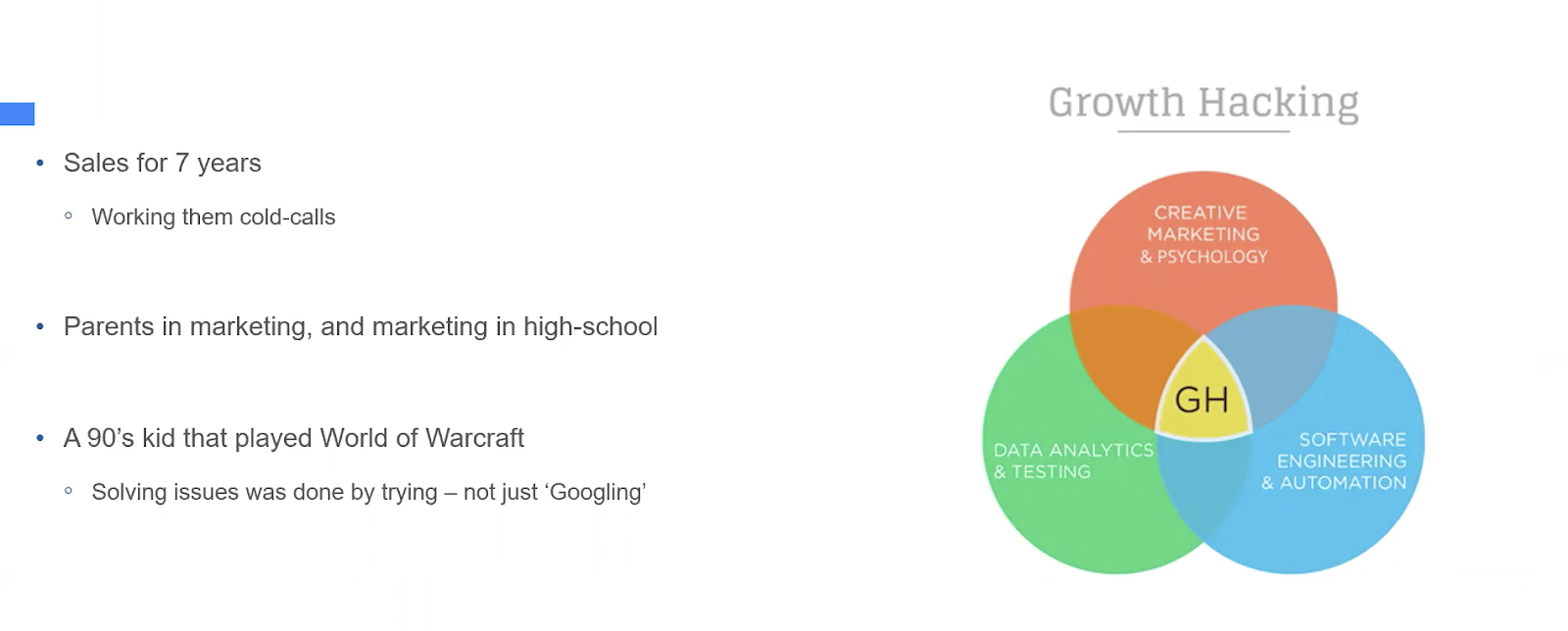
What that does to you is gives you a really good idea of what people want. How do people react to the way you communicate with them?
Why is this important? This is how I think.
I like to say that when people are working as a growth hacker or in marketing in general if you've never actually tried to sell to anyone, how do you know your ad specifically works?
Of course, yes, you can see your data, but the first time you're doing that you don't have this gut feeling of "this is going to sell, this is going to work because I've talked to 100,000 people before and I know that if I sell to Betty, she's going to trigger on these words".
That gut feeling is something that takes years of experience to get to and that's really powerful and you get that from sales. I like to say that's a creative marketing and psychology package of me. That's where I get this from. This is what contributes to how you understand growth hacking.
Parents in marketing
My parents have worked in marketing my whole life, I started marketing in high school, I've done marketing for quite a long time.
World of Warcraft kid
I've also always been a kid that played World of Warcraft and games.
Back in the day, when you played World of Warcraft there was barely a thing called Google, you had to solve the things by doing and not just by googling - you have to figure out ways to do this yourself.
This software engineering and automation approach to everything comes from this deep-rooted feeling of "I have an issue I have to solve it somehow". I'm super creative and at the same time when I joined Templafy, I got the last leg of becoming, in my opinion, a growth hacker and effective at understanding growth. I started to understand metrics, data analytics, and testing, which is the last part of it.
This was a big contribution of my bosses at Templafy, that was the last leg I was missing.
Growth Hacking vs Head of Growth
Why is growth hacking different? And why is head of growth different than a growth hacker? That's a very important distinction.
Everyone does growth
First of all, everyone does growth, absolutely everyone does growth. If you go into a company and they say they don't have growth, they're probably not going to get the next promotion.
Growing revenue profits is at the core of what you do as a business. Every function is technically responsible for the pursuit of this goal.
Exclusivity
The deep understanding you should have is that the head of growth, also typically a growth hacker, focuses on this exclusively.
Departments as integrated functions
It means this person does this by viewing departments as integrated functions.
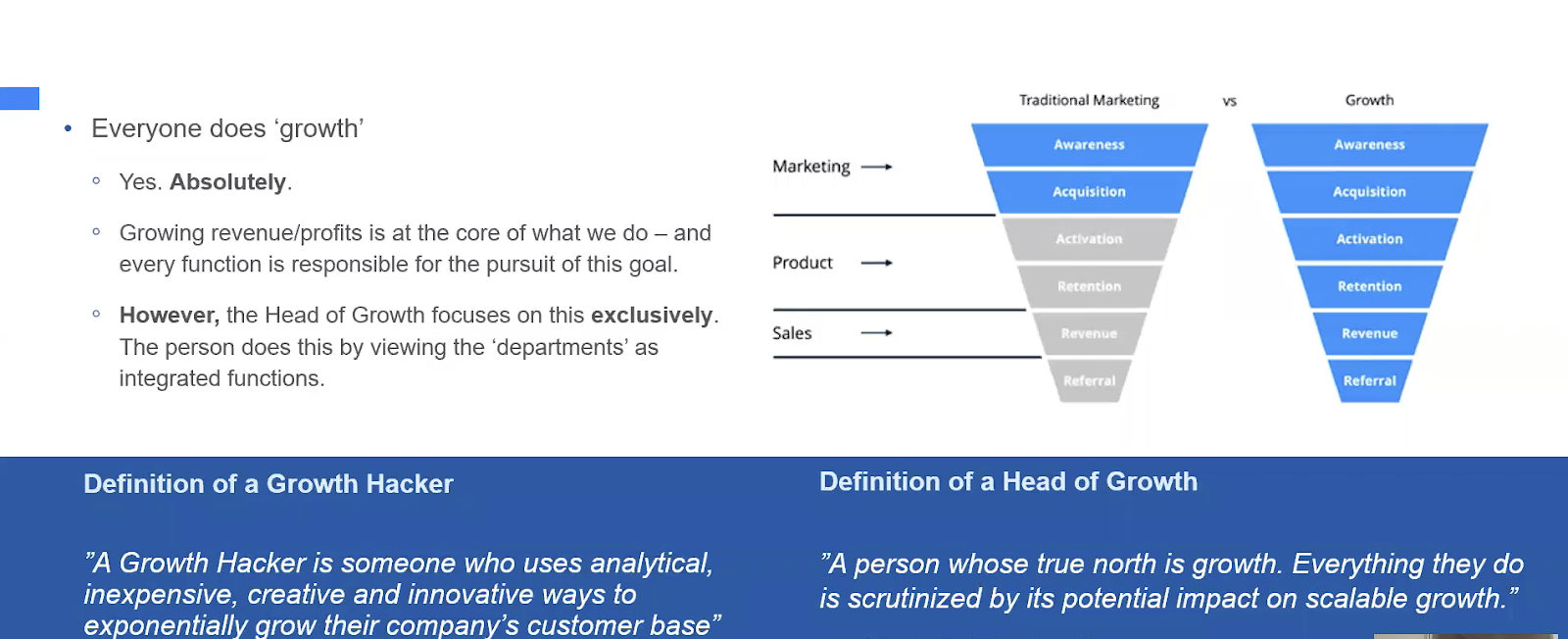
Traditional marketing vs growth
A good example is to look at traditional marketing which is typically focused on awareness and acquisition - we need to get the product out so we can get some leads that can end up in the pipeline and become customers. Traditional marketing will say, "We made this beautiful campaign, why are you not selling it?".
Whereas in the Head of Growth role, I'd say, "We sold these products. How can we backtrack that to everything we did? How can we optimize the different departments and different things we're doing in order to achieve more? Where are the growth levers we can pursue?".
In essence, growth functions across all parts of the funnel. I like Neil Patel’s framing of a growth hacker as “Someone who has analytical, inexpensive, creative, and innovative ways to exponentially grow their company's customer base”.
Whereas a definition of Head of Growth is a more holistic view, “A person whose true north is growth. Everything they do is scrutinized for its potential impact on scalable growth” - Sean Ellis.
Essentially the differentiation between them is a growth hacker is something very low to the ground of growth and the Head of Growth is more running operations, running teams, running ideation processes, and things like that.
About Templafy
Before I dive in, I want to make sure you know where I'm coming from.
Document anarchy
Essentially, Templafy solves a problem called ‘document anarchy’.
Every day employees produce thousands of documents, presentations, and emails, but they don't always use the latest company standards. That is what we call ‘document anarchy’. It's a big problem out there for a lot of large corporations.
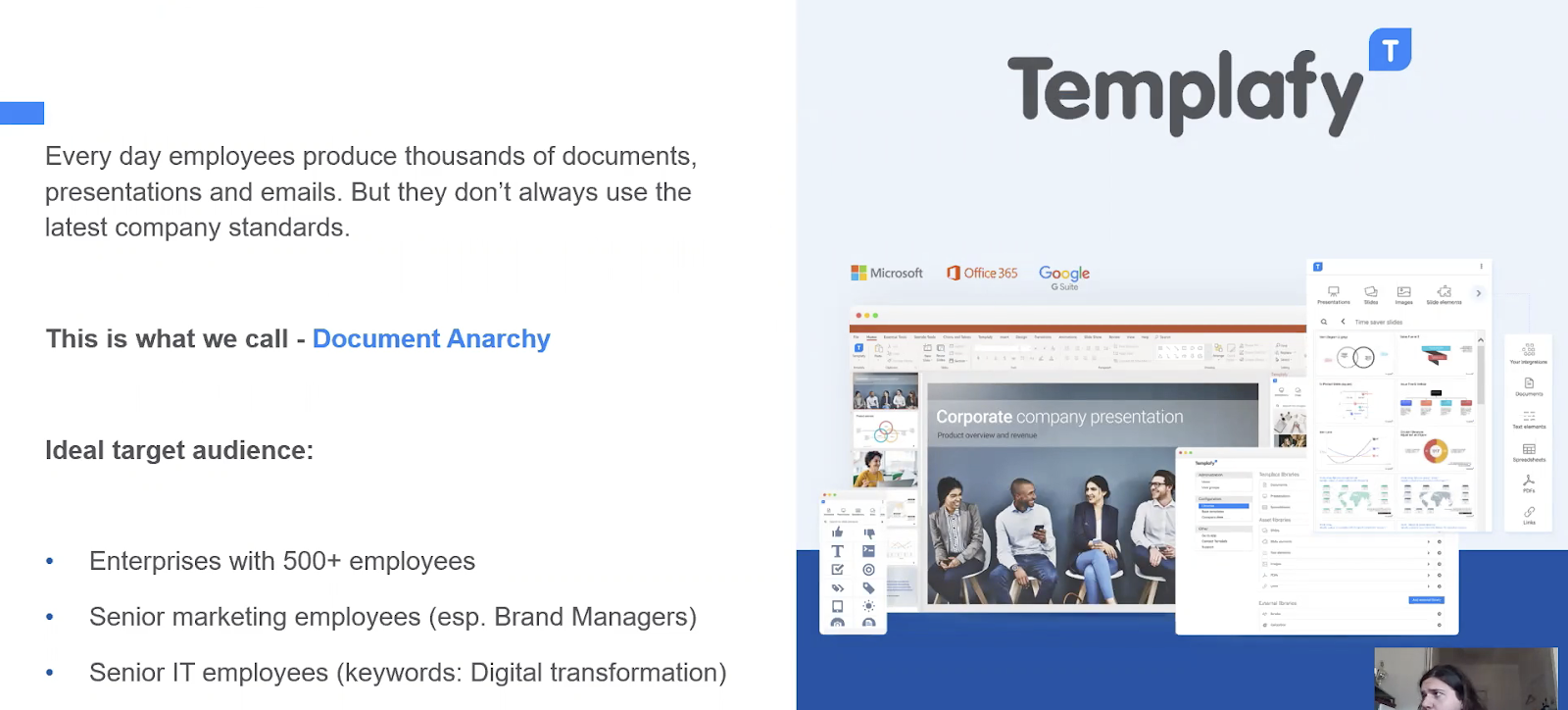
Imagine you have to change your logo, how do you get the new logo out to 50,000 new people? The first thing they're all going to do is go to Google and search, 'What's our new logo?'. That's a big deal.
Ideal target audience
Typically, we deal with enterprises with above 500 employees, and we target senior marketing employees, especially brand managers because they have the pain. Those are the people where they can really feel they don't have a tool to solve this issue for them.
At the same time, we look for senior IT employees, with the keywords being digital transformation - CSOs, and stuff like that.
Typically, these people are tasked with carrying out digital transformation for their companies, taking large organizations into the cloud, into the future, and Templafy is a big part of that.

It's been really interesting to be a part of Templafy during the COVID-19 crisis, mainly due to the fact Templafy is a really good product for actually working from home - you have access to all your assets.
Suddenly that means a lot of companies in some cases have actually sped up, they've been running faster, whereas other cases have been running slower for us thanks to the crisis. It's an interesting aspect.
The AIDA model
In my humble opinion, this is the only model you'll ever need if you're in growth marketing. It's old school and it's called the AIDA Model. There's a bunch of different versions out there, I'm not gonna go through them all, I'll keep it simple.
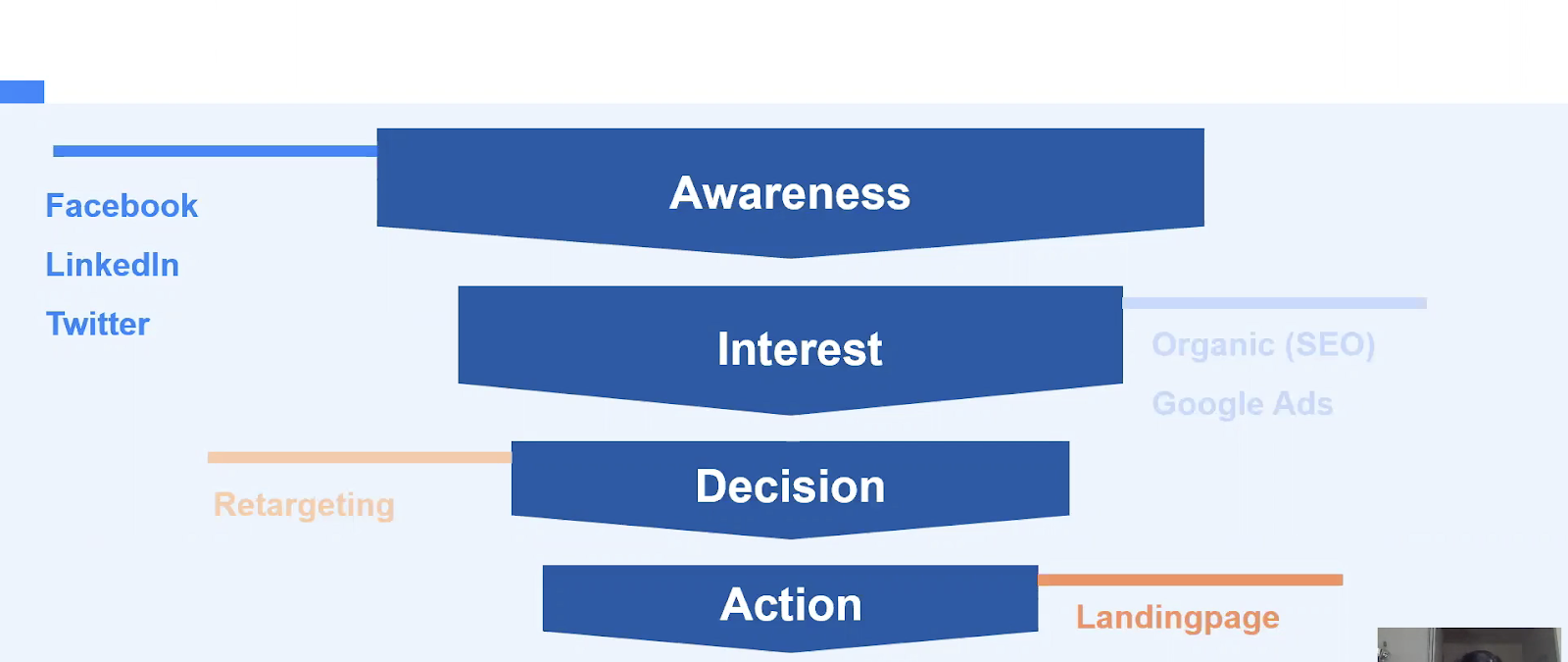
Essentially, awareness, interest, decision, action. It's super simple. My point of this is saying, when people start out doing marketing or start out doing growth, they always have a tendency to start out at the top.
They go, "Hey, I just want to do some Facebook ads and they're gonna be great. I'm gonna shoot them out to a bunch of people, and I'm gonna see what happens". That is a fine approach if you want to test your MVP or just want to get some feedback. That's fine.
But initially, when you only have let's say $10,000 for your first campaign and that's your entire marketing budget for a year, why do you want to focus on putting people through a big funnel? What you want to focus on instead is taking the people who are actively looking for a solution that your product solves.
A good example of this is saying the people who search for a template management software for a large enterprise, that person is ready to buy your system. He's ready to buy Templafy.
There might only be one of them, but he's in the action phase, decision phase, and slightly in the interest phase - imagine he's searching for PowerPoint online, and he's already showing some interest in the field.
Here organic efforts and Google Ads become way more interesting as a proving model for saying:
- Does what I'm trying to sell have legs?
- Is anyone searching for this?
- Is anyone looking for this?
The thing is, with Templafy, our sales cycle used to be around four to six months, it's closer to less than four months today. However, if you're scraping by and you want to be sure to get your quota, then you don't want to get the people who are taking six months plus to convert, you want to get the people who are ready to convert within two to three months.
Yes, they might be more expensive initially. But the first thing you want to do is prove you have a reason to exist.
1. Identify the metrics that matter
Why does marketing exist?
Let's talk about metrics. I love metrics. But first, let's ask why does marketing exist? Very simply put, marketing exists because we need to make sales, we need to close customers, and need to generate revenue. That's why we exist.
We don't exist to create beautiful banners. We are here for the same reason as sales are - to generate customers. The end.
Metrics
Why are people focusing on the wrong metrics? Essentially, what happens today, in my opinion, is people are focusing on what I'd like to call vanity metrics.
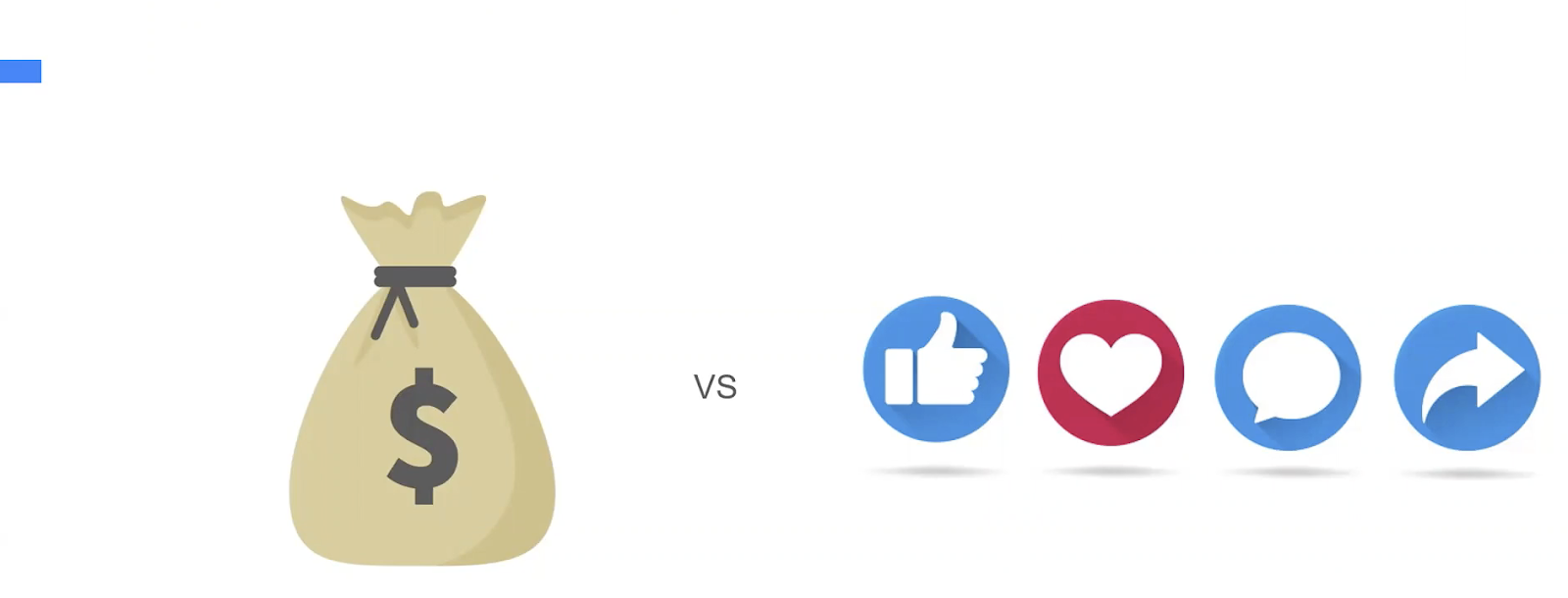
Skip the vanity metrics
One good example of a vanity metric is saying, "Hey Casper, I've just made this beautiful social post, and it got 1000 likes on LinkedIn".
Okay, beautiful, I'm not saying that's a bad job, but how do we tie that directly into revenue? Can we do that? "Yeah, but Casper, I got 500,000 followers in the last month on LinkedIn". First of all, that's crazy, but is that the metric that matters?
Those 500,000 people you generate as followers, have they generated revenue? Do you have a plan for making them generate revenue? No, you don't. So stop focusing on these metrics that don't really matter.
Video example
A good example I always use is the video example. I'd rather have a video that's seen by 100 people, but the hundred people have seen it for at least 50% of the video, let's say it's long-form, then have a video that's seen by 1000 people, but that engagement time is lower than two seconds.
What does it matter if 1000 people have seen my video for three seconds? They're not gonna understand Templafy in three seconds. So that's not a metric that matters. View and reach can typically be a metric that does not matter.
Metrics that matter
I'm not saying all metrics are bad, but you have to find the way to the metric that matters to you. A lot of people talk about cost per click and cost per lead, I don't give a monkeys about cost per click. What does it tell you? It just tells you how much it costs for people to land. It doesn't tell you how much you converted.
I'll show you how I would do it instead.
Case in point
A good example here is some of our old Google Ads data I’ve pulled up to prove a point.
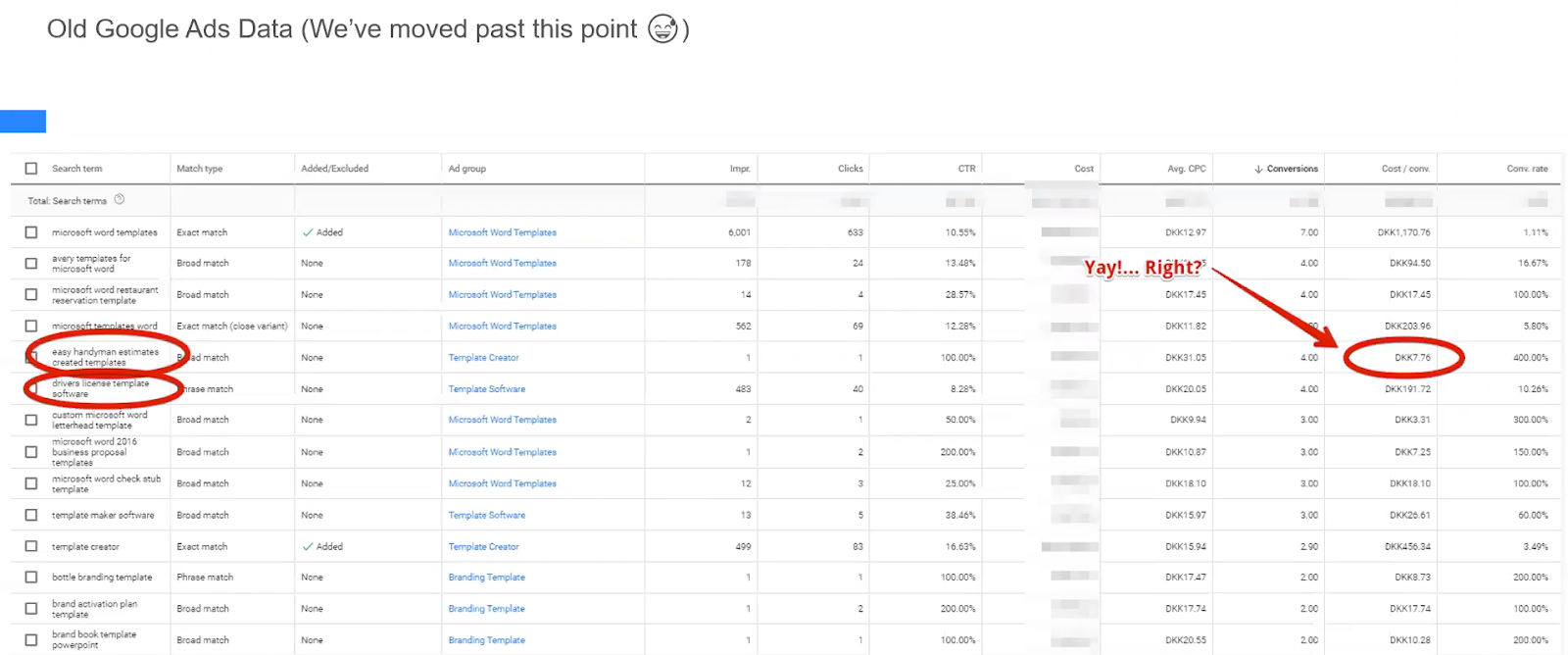
If you look at cost per conversion, it could be higher, this is essentially how much does it cost to generate a lead, in our case, a person who signs up for a demo? The image is in Kroners but I would amount to approximately one euro or $1. That's pretty cheap.
So $1 to get cost per conversion, great, right? That's awesome. Then you go to the left, and see somebody searched for ‘easy handyman estimates created templates’, or ‘driver's license template software’.
That's definitely not what we do with Templafy. We make template management solutions for big enterprises, these people are searching for small-time solutions. Needless to say, while our landing page might have confused these people as to why did they even convert in the first place? That's a different discussion.
But the interesting part here is saying, this doesn't tell us if this became a customer. This doesn't tell us anything about what happened after the lead came in.
The problem arises here that if by following the data you get from here, in this case, Google Ads and then you say to Google, "Hey, I just want you to optimize for the lowest cost per conversion", what Google is going to say, "Okay, all these easy handyman estimates, created template searches, those are great, I should try to get more of these people".
That's the wrong way of doing it.
How to apply useful metrics in the real world
We know this is not how we should be treating our metrics, so how do we apply this to the real world?
The Northstar metric
I want to introduce you to a simple concept invented by Sean Ellis and then I'll show you the metric part of it. You want to start with the Northstar metric, defined by Sean Ellis (he wrote a brilliant book on it, read it).
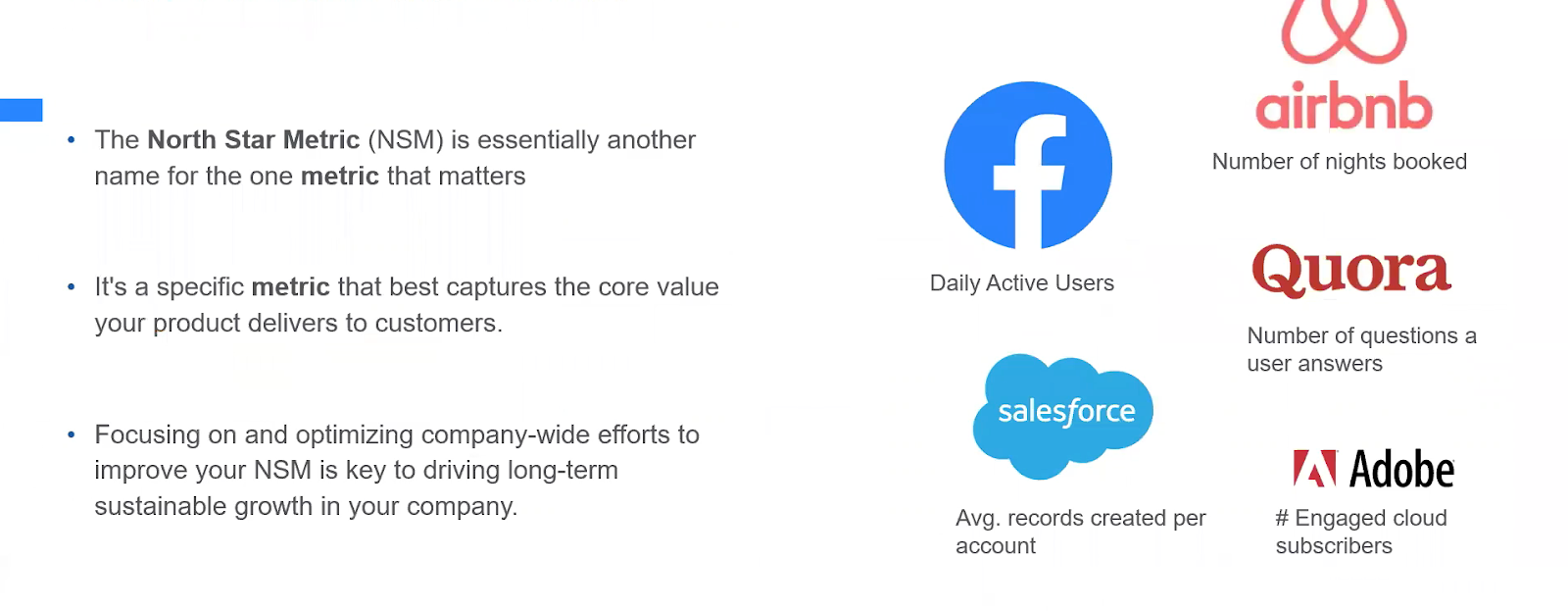
The Northstar metric is a name for the one metric that matters. This metric is the one that everyone in the organization can get behind. It's a specific metric that captures the core value your product is trying to deliver to customers. If you focus on this metric and try to optimize it company-wide, you'll improve your Northstar metric and that will be the key to driving sustainable growth in the long term.
Examples
Good examples to pull up here:
- Facebook has daily active users,
- Airbnb has number of nights booked,
- Quora has number of questions a user answers,
- Salesforce, average records created per account,
- Adobe, engaged cloud subscribers.
A caveat
I have a caveat for these Northstar metrics. The reason I bring them up is it's a bit of a twofold relationship. First of all, I think it's brilliant as an organization to reach a point where you can define a Northstar metric.
A Northstar metric, however, is not the first thing you should go out and do, which is why I've included this here. If for example, you’re in an organization with 30-40 employees you might not have a Northstar metric yet, it might not be very crystal clear what your Northstar metric should be.
Secondly, this can be very hard to track initially. To begin with, you want to make sure to generate revenue.
For a large part of Templafy’s existence, our Northstar metric has been MRR - monthly recurring revenue - if we're generating monthly recurring revenue we're doing quite well.
Eventually, we moved it over to saying also daily active users just as Facebook, but it has been a bit in between and my point is it's not crystal clear where the shift happens, but my best guesstimate is the Northstar metric is not something you should focus on if you're less than 50 employees. At that point, it doesn’t make that much sense.
Northstar metric makes a lot more sense the bigger you get because then it suddenly becomes clear this is something everybody in the organization can work towards.
If you're great at doing it when you're five people, by all means, go ahead. That's not where you should start.
What happens when you look at data
Before I talk about data I just want to point out this data is two years old or something so don't worry too much about the numbers, this data is about what happens when you look at data. I've even fixed it so it doesn't really show much, it's just to give you an idea.
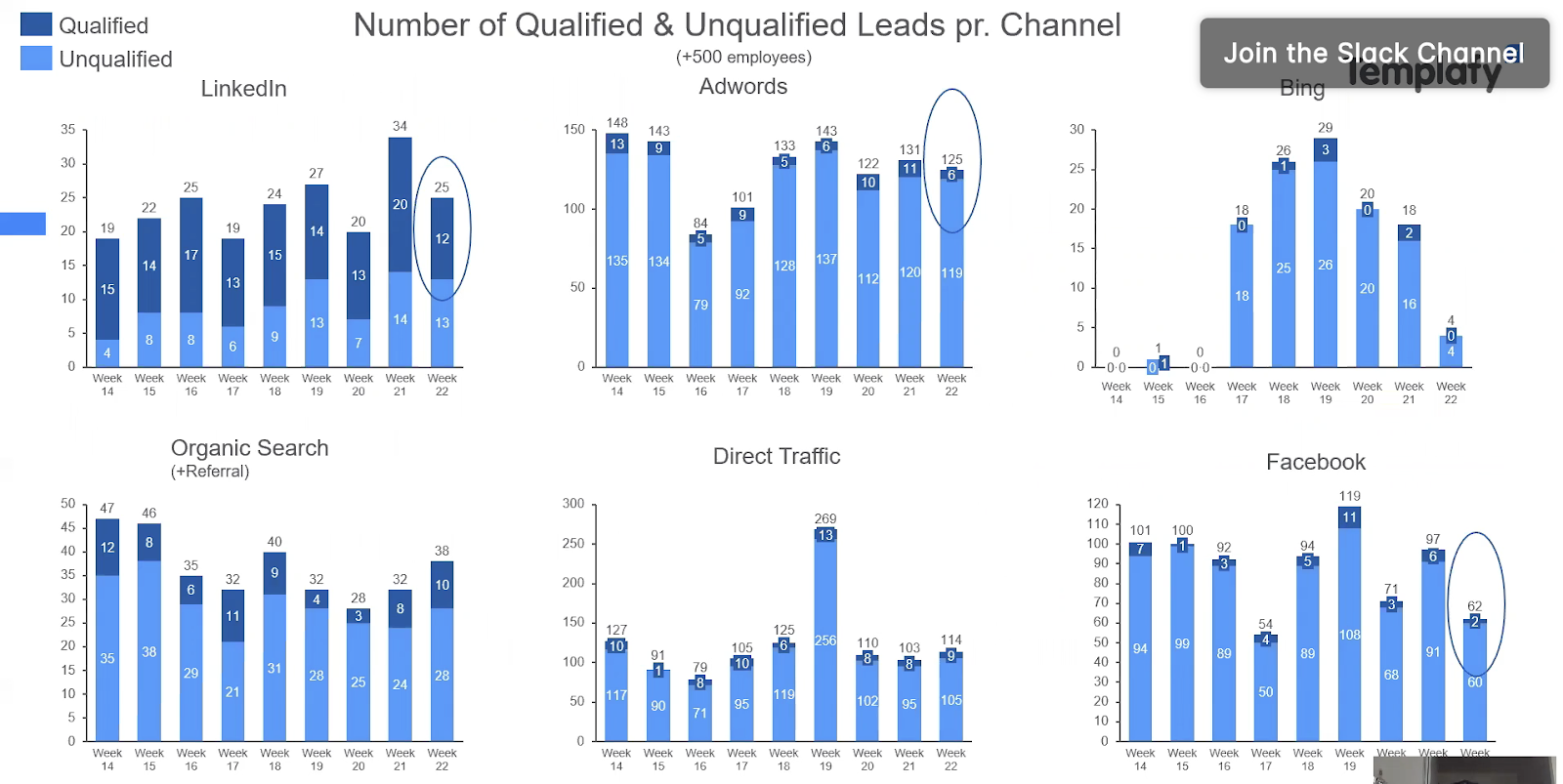
Qualified and unqualified leads
First of all, this is showing the number of qualified and unqualified leads for a channel. If you look at this slide only, you'd be like, "Okay, LinkedIn looks like a great channel, from LinkedIn, we got 12 qualified leads per week".
That's great, that's better than what we get from AdWords, where we only get six qualified leads per week, or better than from what we get from Facebook, right?
If you only look at this level, which if you use an agency for marketing activities, this is the level they look at typically unless you tell them otherwise. This is where it's so wrong. This will not tell you anything about the customers.
Let's try to dig a little bit deeper.
Cost per qualified lead per channel
If you get to a better agency this is what they're talking about. Or maybe you're a marketing professional, and this is what you thought mattered for a long time - you could look at the cost per qualified lead.
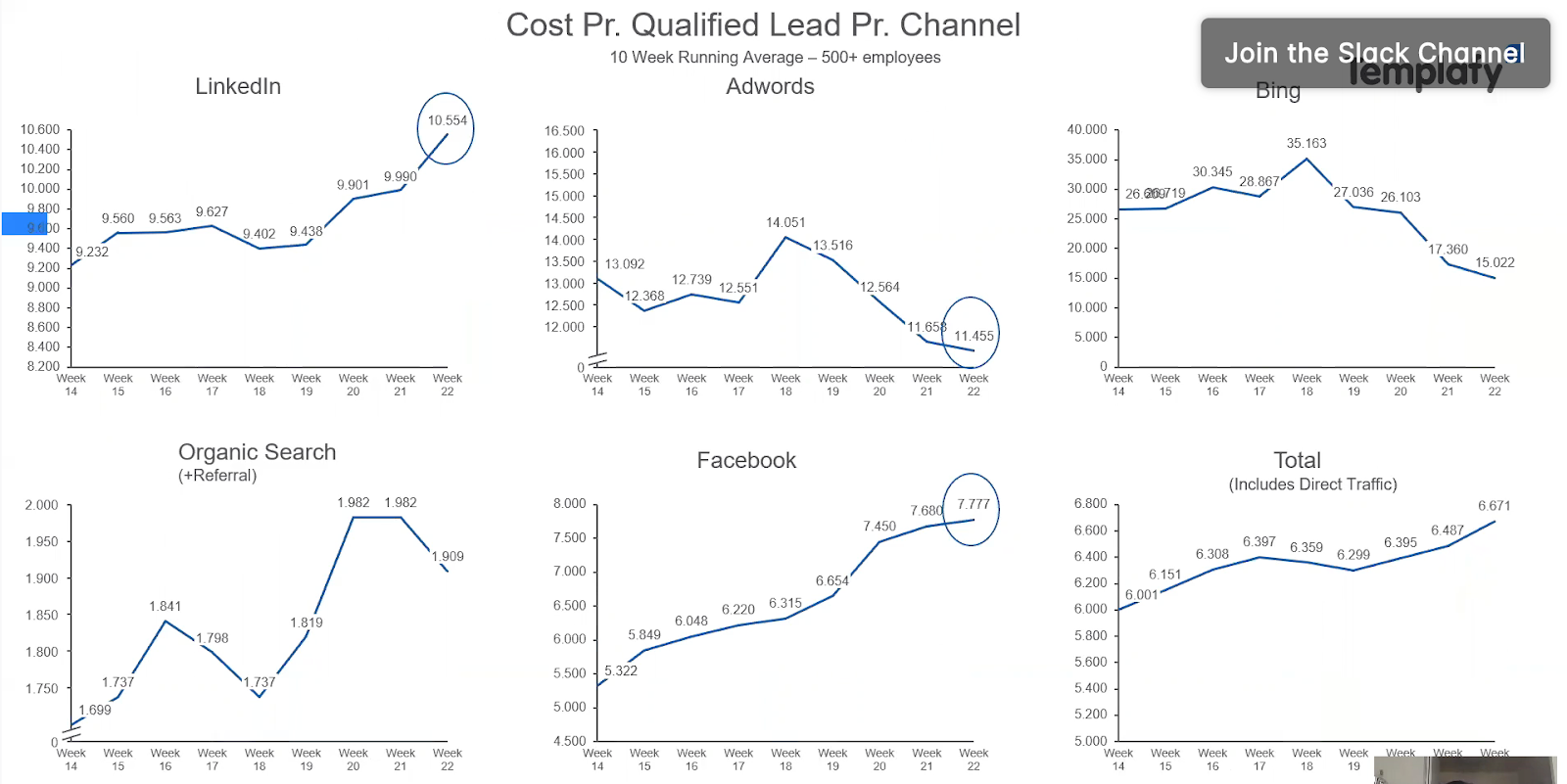
Let's say you paid 10,000 Kroners for a qualified lead from LinkedIn, you're paying 11,000 for a lead on Adwords, and you're paying 7000 for a qualified lead on Facebook. If you only look at this then Facebook is suddenly the good one here, we're only paying seven and a half thousand for a qualified lead. That's great, right? That's where we want to be.
Again, it does not tell you anything about what happens afterward.
Cost of achieving one DKK opportunity MRR
The point I'm trying to make is, this is where you want to get to, you want to get to a point where you can say how much it costs for me to achieve one Kronor or one Euro or one Dollar, of opportunity monthly recurring revenue.
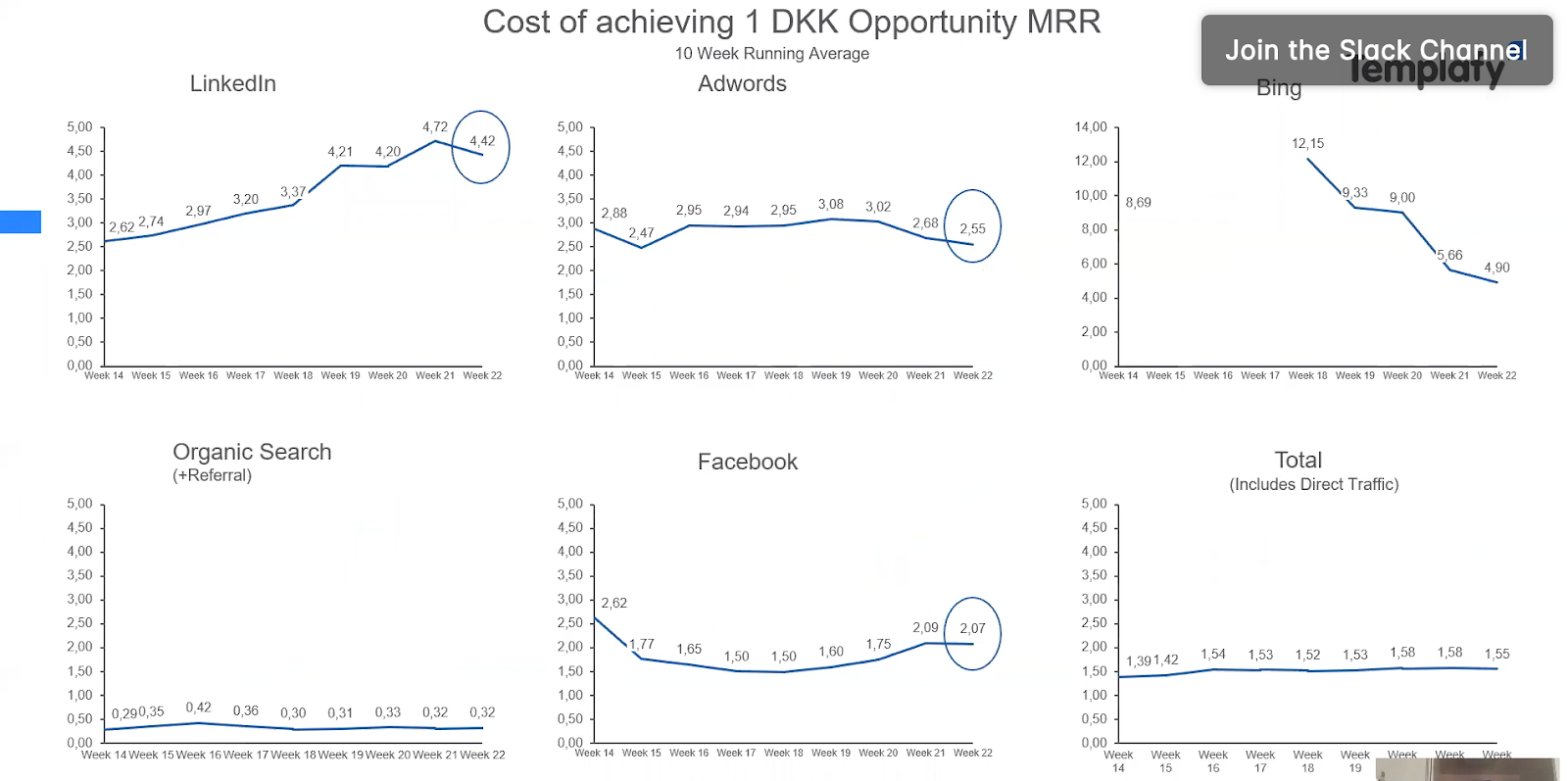
Essentially, what this slide is saying is it cost me about 4.4 Kroners to achieve one Kronor opportunity. If you just look at it like that you'd think, "That's a bad deal Casper, it seems like an awful deal". First of all, in Templafy's case, once we're in the opportunity phase, they're pretty close to closing.
Secondly, when we sign contracts we sign them for a long period, so the actual real value is one times a multitude, so the value is definitely there.
You want to get to this point because now you can actually evaluate how much it costs you to achieve MRR. And if you look at it here, in this case, from this particular week, it looks like Facebook is the one that gets you the most bang for your buck.
Whenever I cast money into Facebook, I have to cast 2.0 Kroners in to get one Kroner opportunity MRR, which would be and is a great deal. Now you know what to do when you want to optimize towards real value. Let's give you a good example of how you do this in the real world.
Now you can optimize after REAL value
Bonus: practical pro tip for stepping up your Google Ads game
This is a bit of a bonus hack. Google Ads has something called a Gclid. It's essentially Google's unique identifier for every time you click an ad. So when you click a Google Ad in the search bar, there will be a Gclid or a unique identifier attached to you.
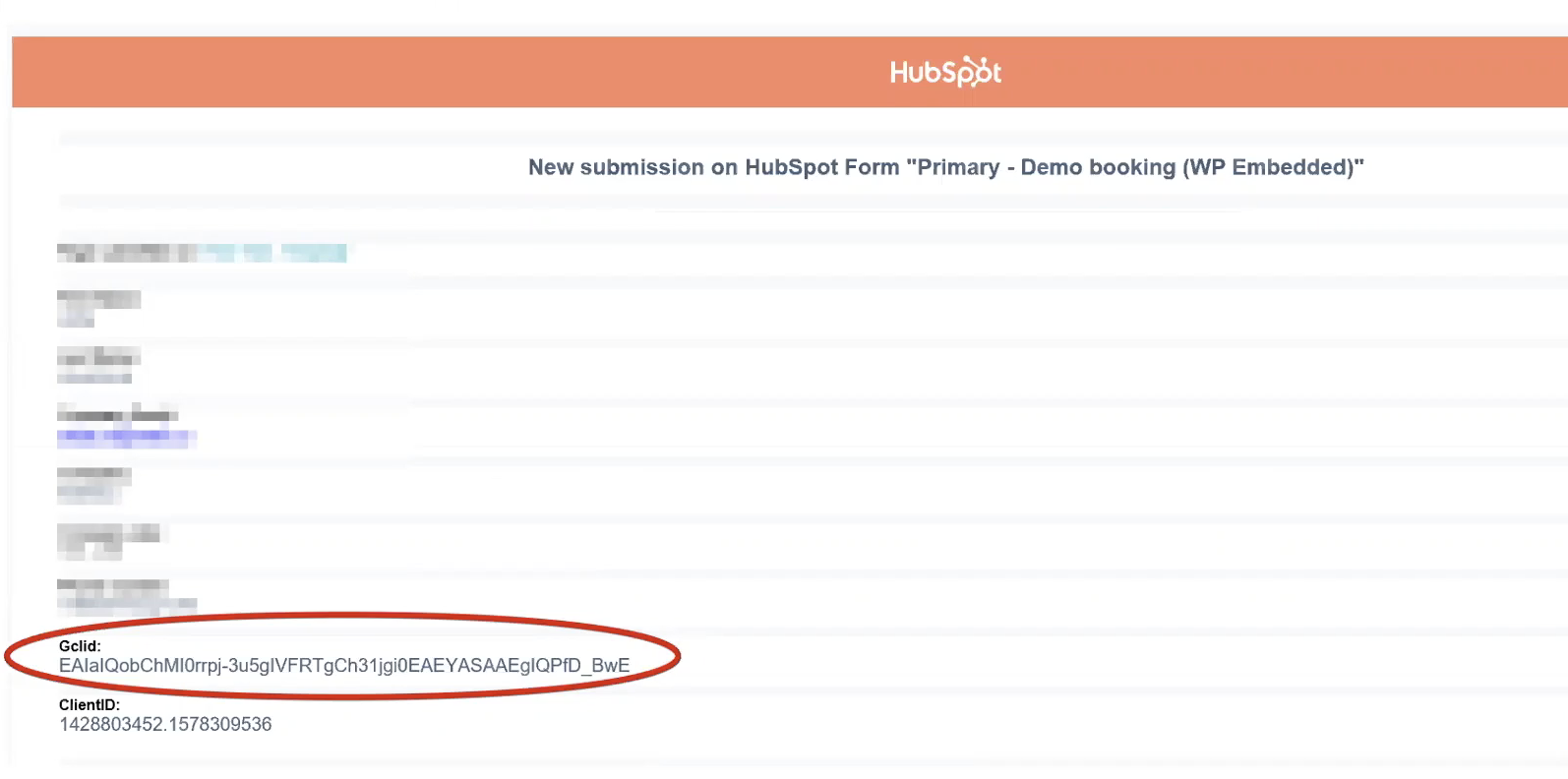
What we did is made a hidden field in our HubSpot forms that collects this Gclid whenever somebody comes in, you can't see this field, you can't see that we're picking up the client ID, that Gclid, but it's picked up. Why does this matter?
The flow difference
Typically the flow difference that happens from this is as follows.
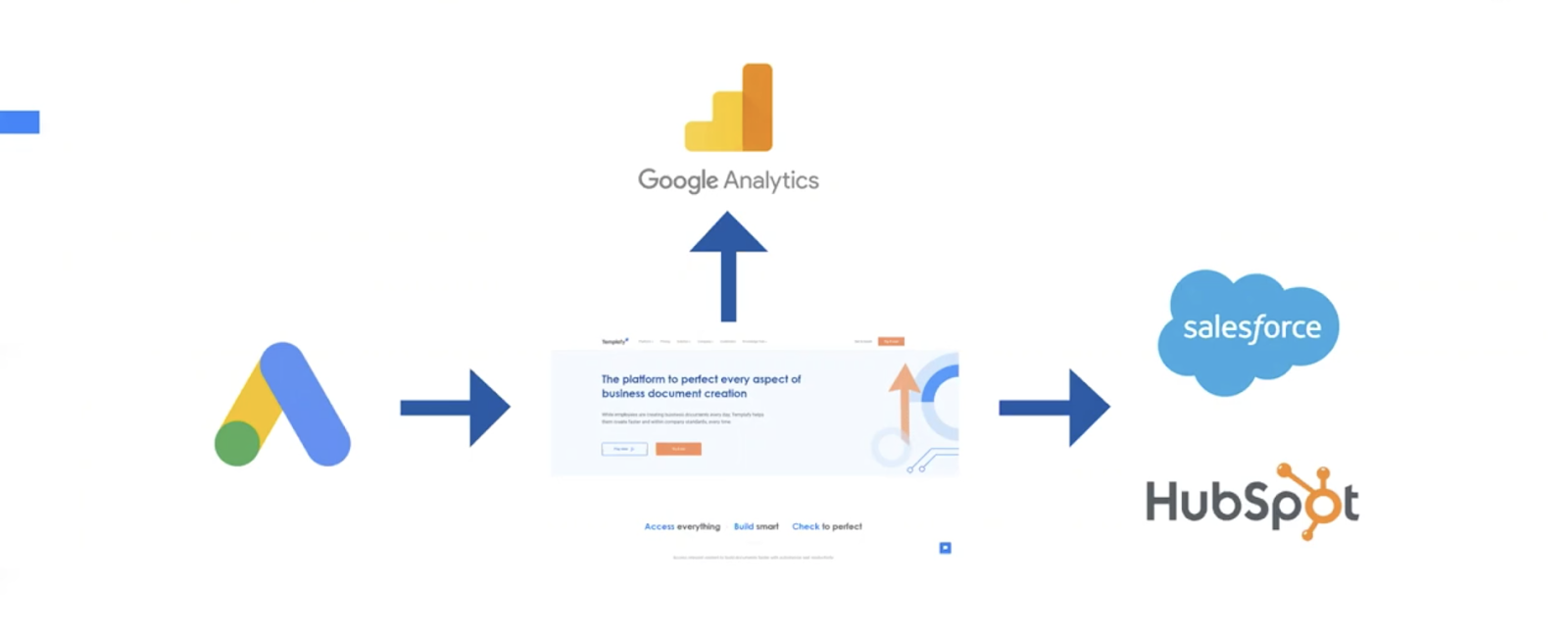
Normally, you would have Google Ads that would send people to Templafy or Patriot, etc, and that would send data to Google Analytics, and if they converted that would send data into Salesforce and HubSpot, our marketing automation, and our CRM systems - normal, typical stuff.
The thing is, there's no talk between Google ads and Salesforce and HubSpot. These guys don't talk together. They're integrated, but trust me, they really don't talk that much. What you want to do is essentially add this parameter where you pick it up and then you want to feed this information back to Google ads.
Now you start optimizing for what actually converts. Instead of optimizing to words ‘handyman templates’, you're now optimizing to the things that actually matter. Let's say somebody becomes a close one customer or becomes an opportunity because maybe you're not closing that many customers so there's a lack of data there.
Let's say the ones that are very close to closing or getting close to it, you optimize towards those people in Google ads. You say to Google, "Hey, Google, I want you to find more of these types of people based on searches". That's where you get the real value and you make a huge difference. That was one of the best hacks we ever did.
One accurate measurement is worth 1000 expert opinions
My point is, if you do the above that I've shown you here in terms of metrics, it's gonna allow you to talk better with the CFO of your company.
The CFO should be your best friend. It's really easy by the end of the year to go to your CFO and just go, "Hey, bro. Here's the thing, marketing generated X amount of revenue last year, whereas outbound activities or other activities only generated this amount of revenue. I want more budget."
That conversation is so much easier than going up to your CFO and saying, "Hey, we spent 100,000 on this campaign, we don't really know what happened, but we think it got traction".
That conversation is so much easier now.

2. Case: applying insights
How we made LinkedIn work for us
We did a test back in the day with LinkedIn, and I want to show how I evaluated if it was a success and how I made it work for us. Essentially, what you want to understand is the basics first, and this is something called the lead gen form.
The lead gen form
In case you're not aware, a lead gen form is essentially a form that's auto-filled, pre-filled with information based on your profile. On LinkedIn, this is typically very, very good because the information on people's LinkedIn is super good. It's very on point.
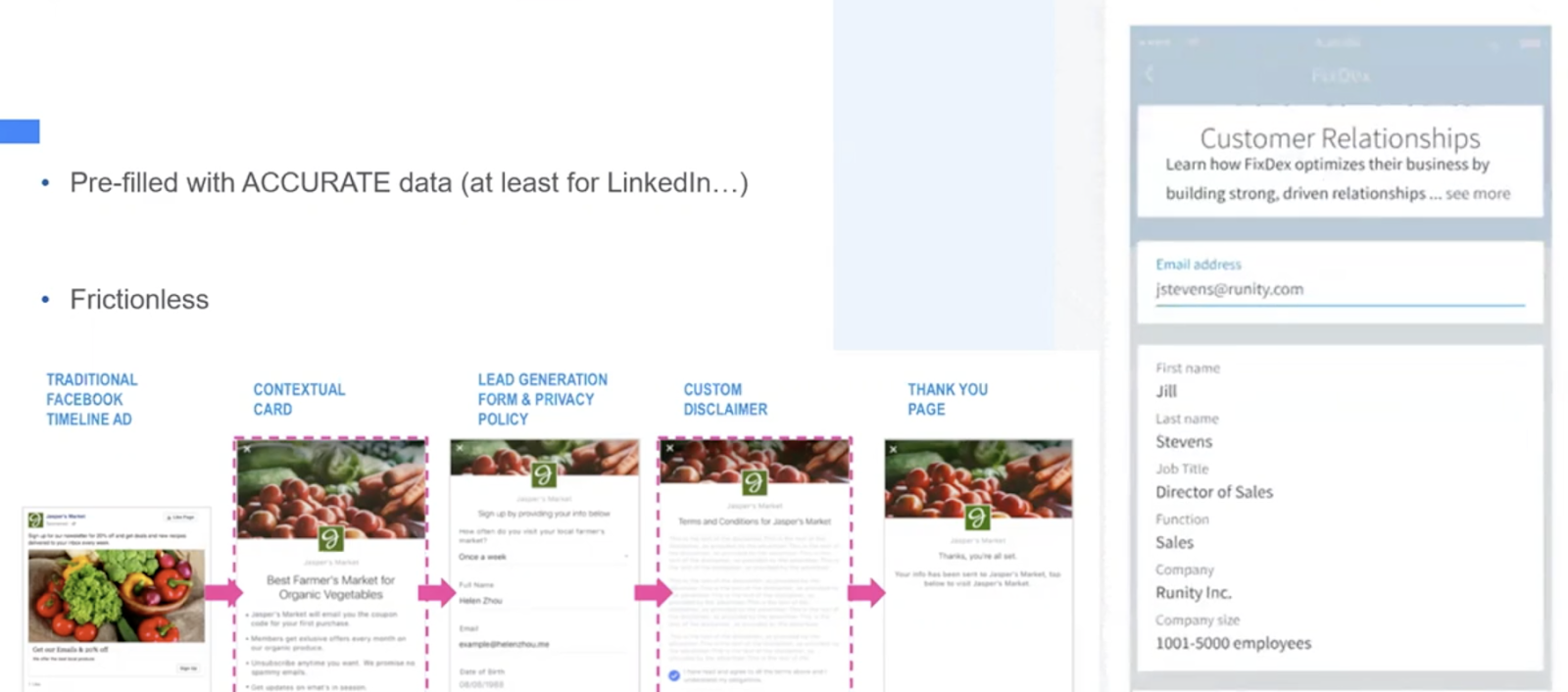
The thing about the lead gen forms is also that they're very frictionless. The reason you typically find a lead gen form provides a lot more conversions than landing page conversion is there's a lot less friction. You can easily imagine that if somebody has to go to your site to convert versus just clicking two buttons to convert, that's a lot easier to do.
What’s the catch?
The thing about lead gen forms is there's a catch.
Knowledge about your product is limited
First of all, knowledge about your product is limited, to say the least. Some of the feedback we got was like, "Hey, this sounded interesting but I don't really know what Templafy's about".
It makes total sense, people haven't really seen Templafy, they haven't seen the website. What are they signing up for?
Low commitment
Secondly, there's low commitment. We got comments like, "I don't know what I clicked on, I just wanted to check it out for myself".
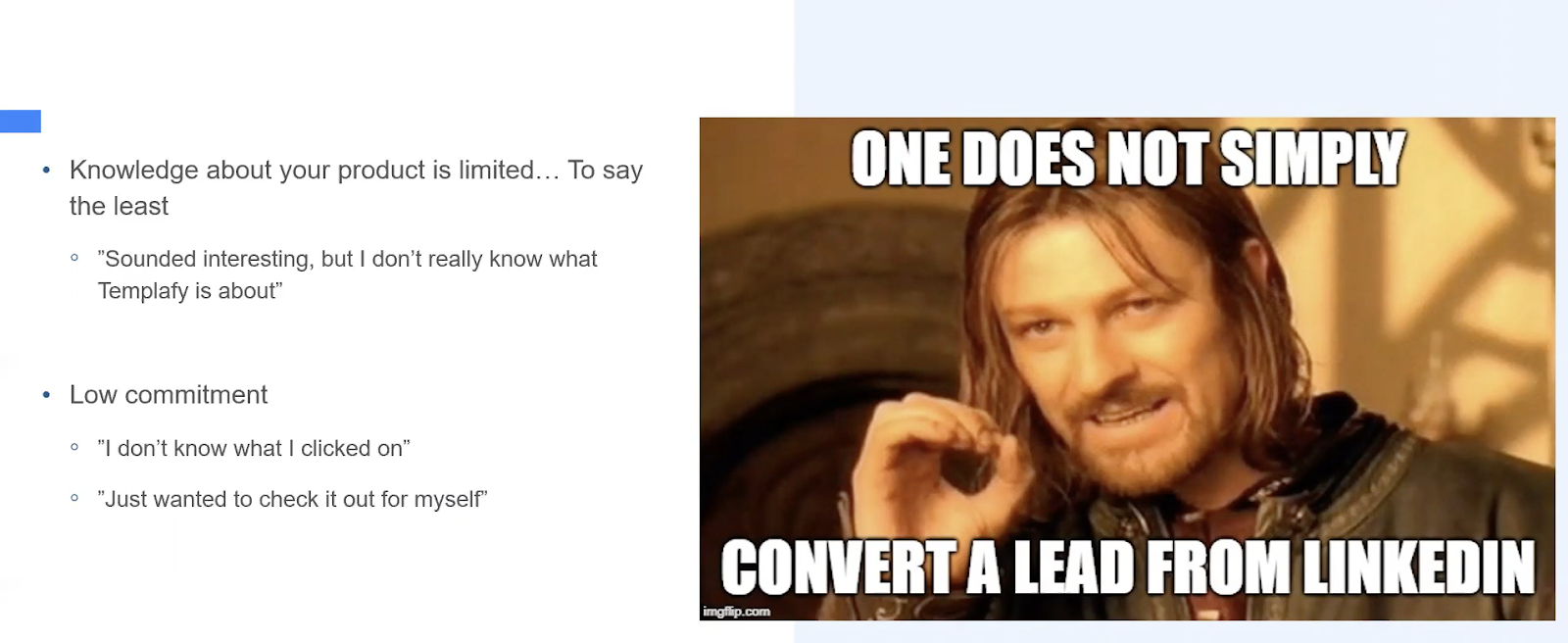
The situation
What happened was our lead to opportunity conversion rate from lead ads was dropping, it was dropping hard. This is an old case, but I think it's really interesting.
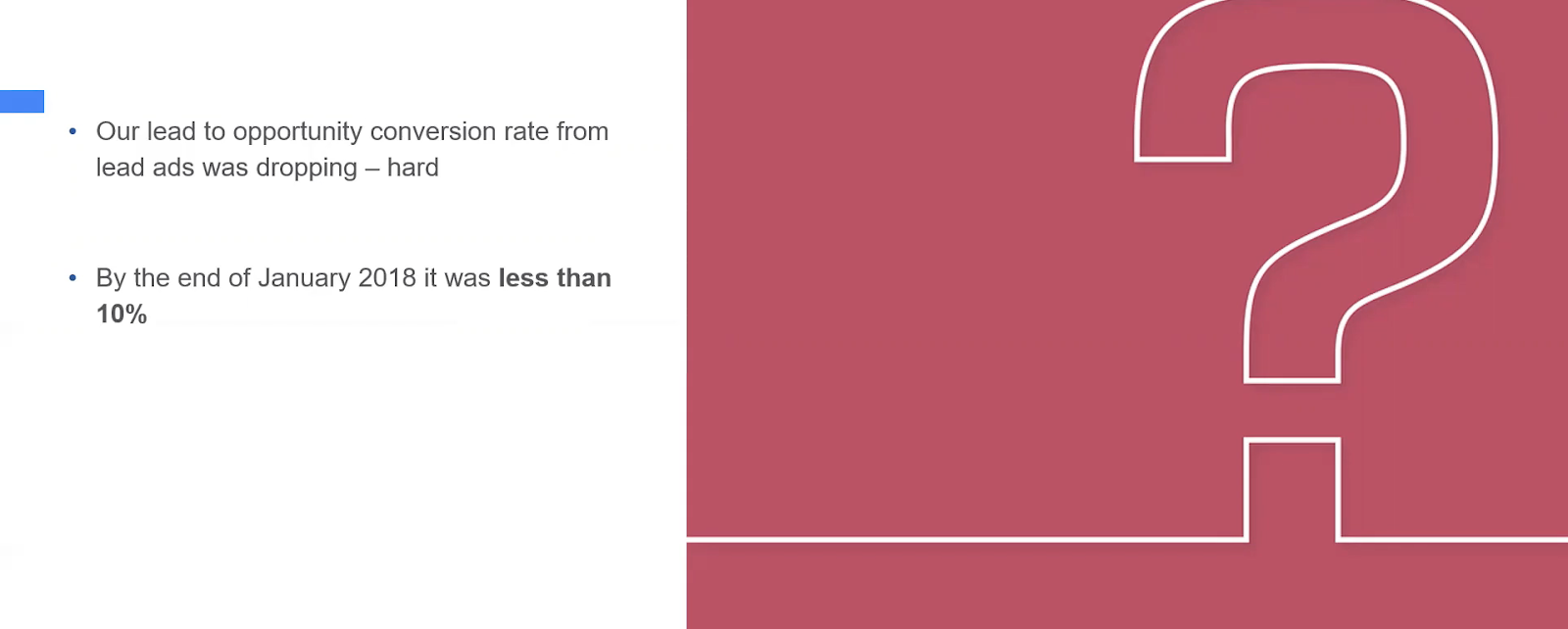
By the end of January 2018, it was less than 10%.
I had an idea.

What if we could personalize our approach and educate the leads before they reach a sales rep?
Step #1: What do we need?
What we wanted to do was make sure these people got more nurtured. We wanted them to understand the product, because the lead part of it, saying how cheap leads we could get - that was good. That was really working, that's the good part about using lead gen forms, especially on LinkedIn.
The bad part was the nurture part so we needed to fix that.
Tools
I set up a test and used a bunch of tools.
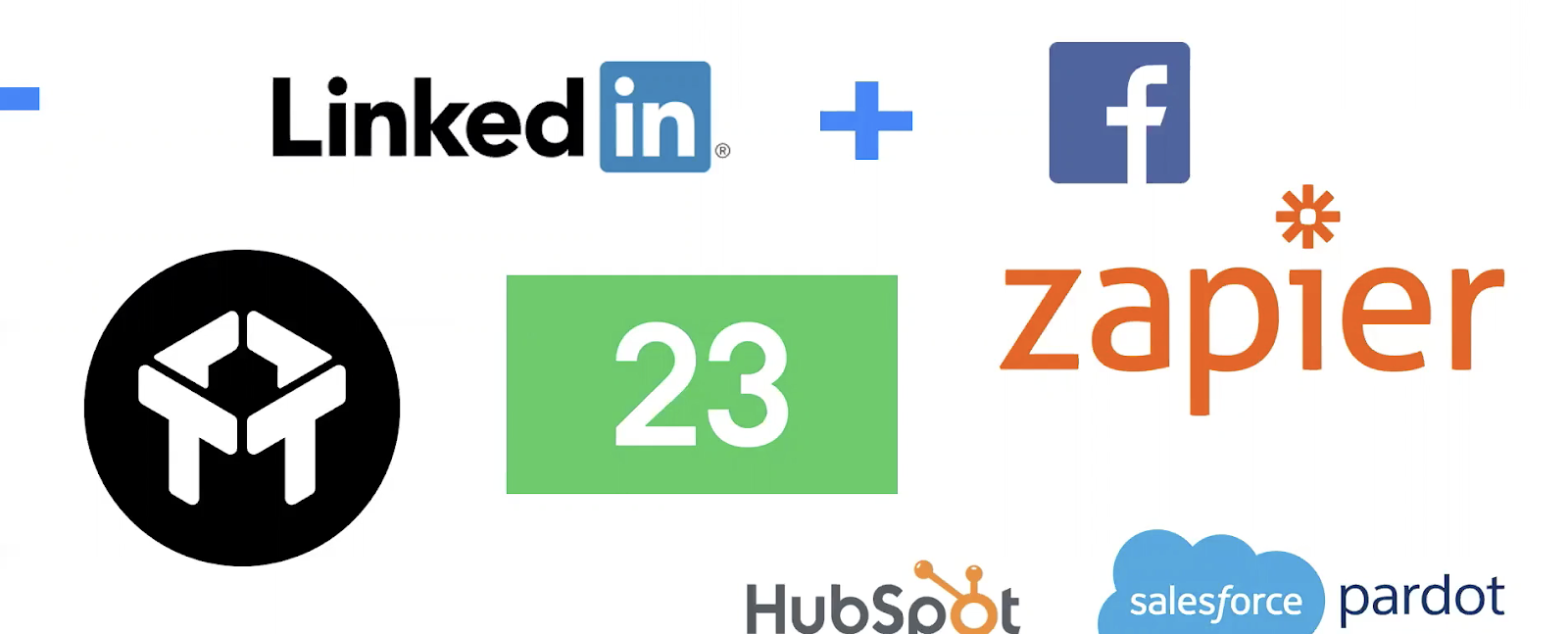
You need a bunch of tools like LinkedIn, Facebook, we use Drift as our chat platform, 23 as our video hub, Zapier to connect it all together, HubSpot as marketing automation, and we used Salesforce.
Step #2: Make lead ads
Second, we want to make lead ads, with or without video it doesn't really matter. We haven't had a really good test with video but some people do. Quite simple and they're nothing spectacular.
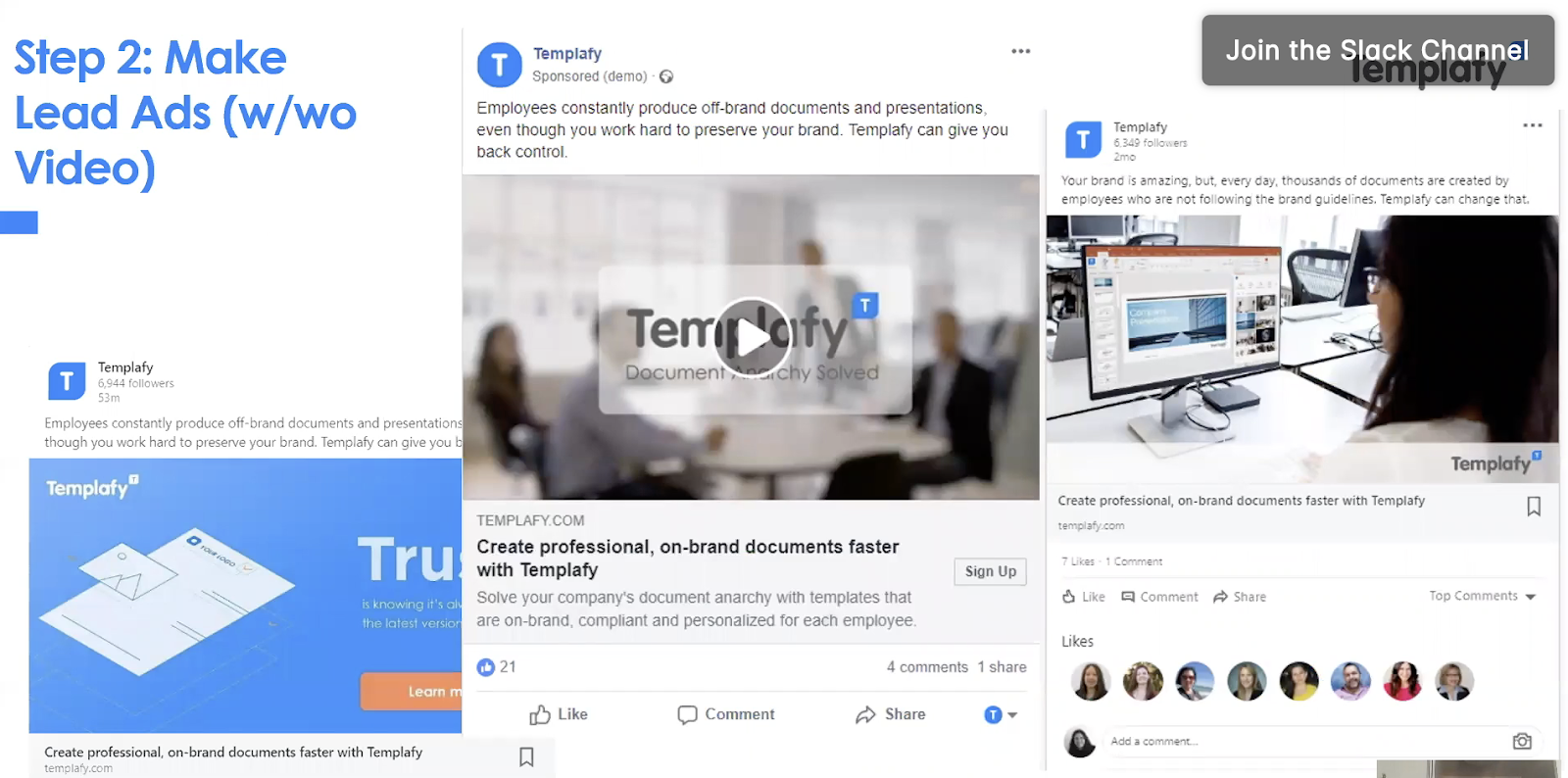
Step #3: Embed emails with video
You want to embed your emails with video so the first thing that happens is when somebody signs up through your lead gen form, you want to send them an email and you want to make it as personal as possible.
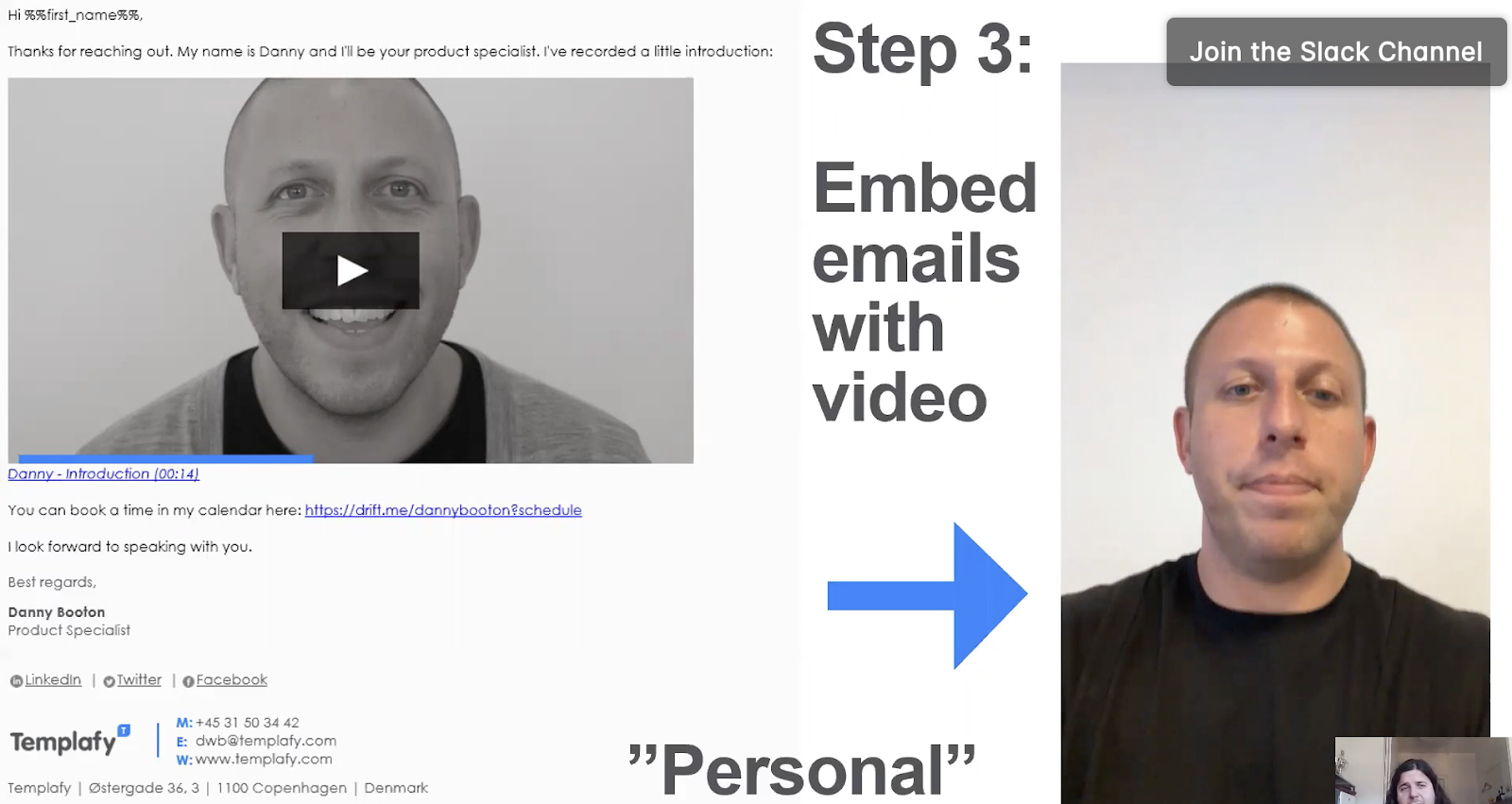
If you’re just signed up for something and half an hour later you get an email like that from Danny, that's pretty good, right? You'd think it seems personal, he shot it on his phone. The thing about it is, it's not personal. So first, we construct a personal email.
The ‘personal’ email
The first email you get is this sign-up, this functions more as a recognition of signing up.
In the second and the third email here we remove all HTML so we make it seem really personal. At the same time, we include a link to a video and we try to chat it up like Danny normally would.

Step #4: Segmentation based on data & make the flow
The next step is segmentation. We do a segmentation based on data and then we make the flow. Essentially what happens is you come in, based on the criteria we brought in from LinkedIn, we segment it out.
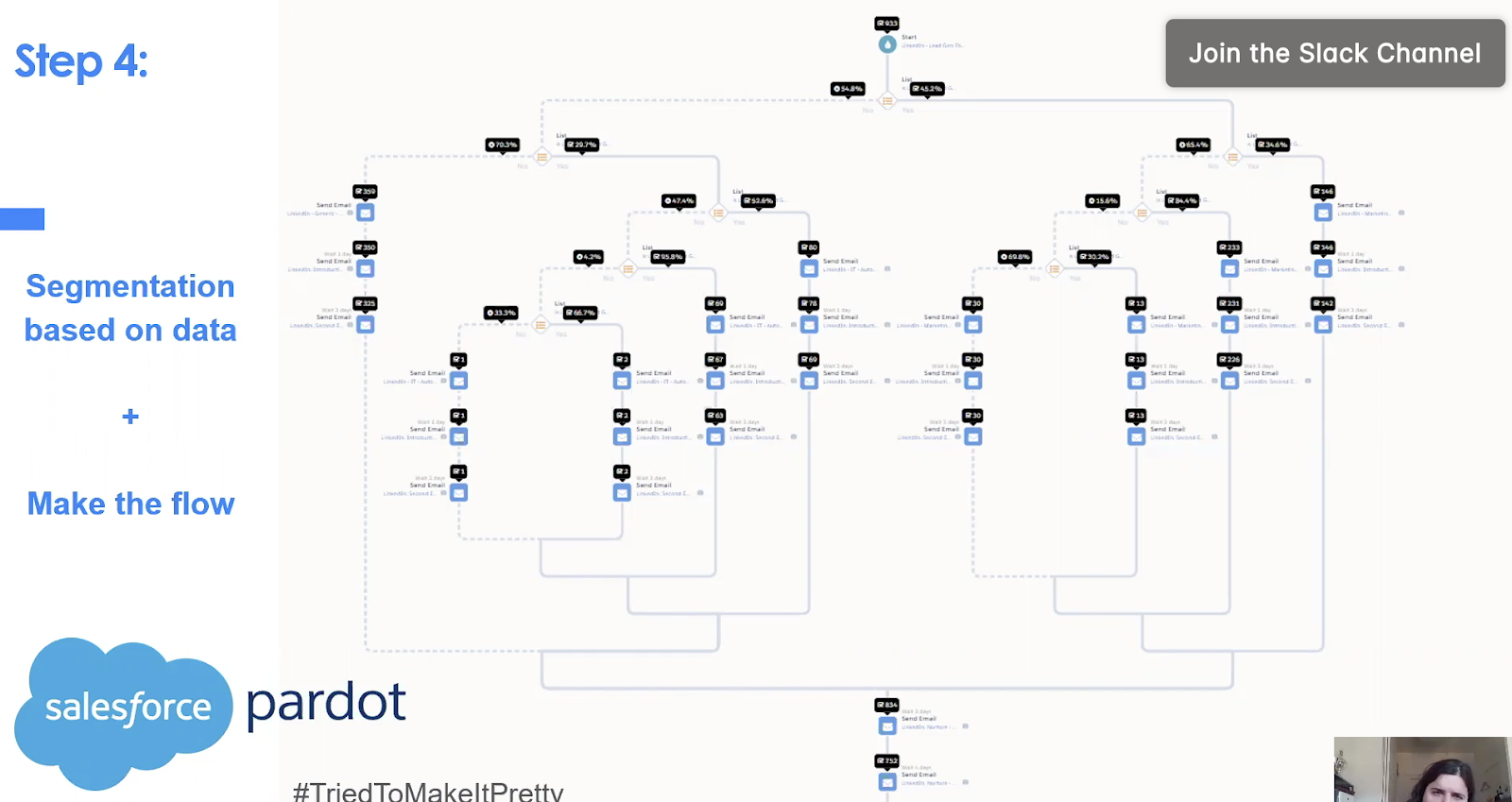
First, we do it on marketing profile, are you in this type of specific job title? There's a bunch of different flows just like this, and then also separated into geo-locations. If you're from this location, you get to be included in this flow for this rep.
It's pretty basic, normal stuff, but when you built this the first time it can be a little bit overwhelming.
Step #5: Make personal drift bots
We also made personal Drift bots - that's the thing I love about Drift is we can make these personal bots that felt like assistants for our reps. The goal was always to create this flow where they would get nurtured and the reps didn't have to do much themselves.
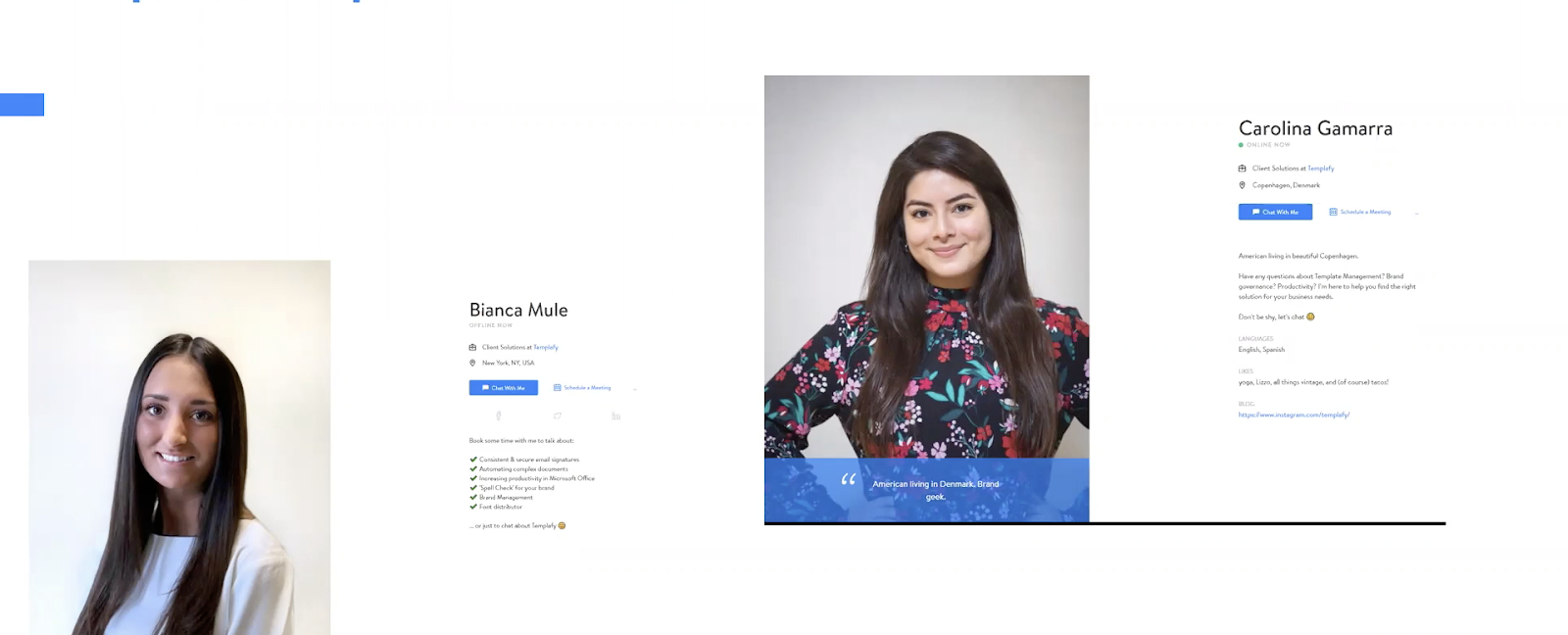
You can see below a good example of somebody coming into temple bots "Hey there I'm Danny's personal assistant” and then you can pick a time and then you can essentially book yourself in.
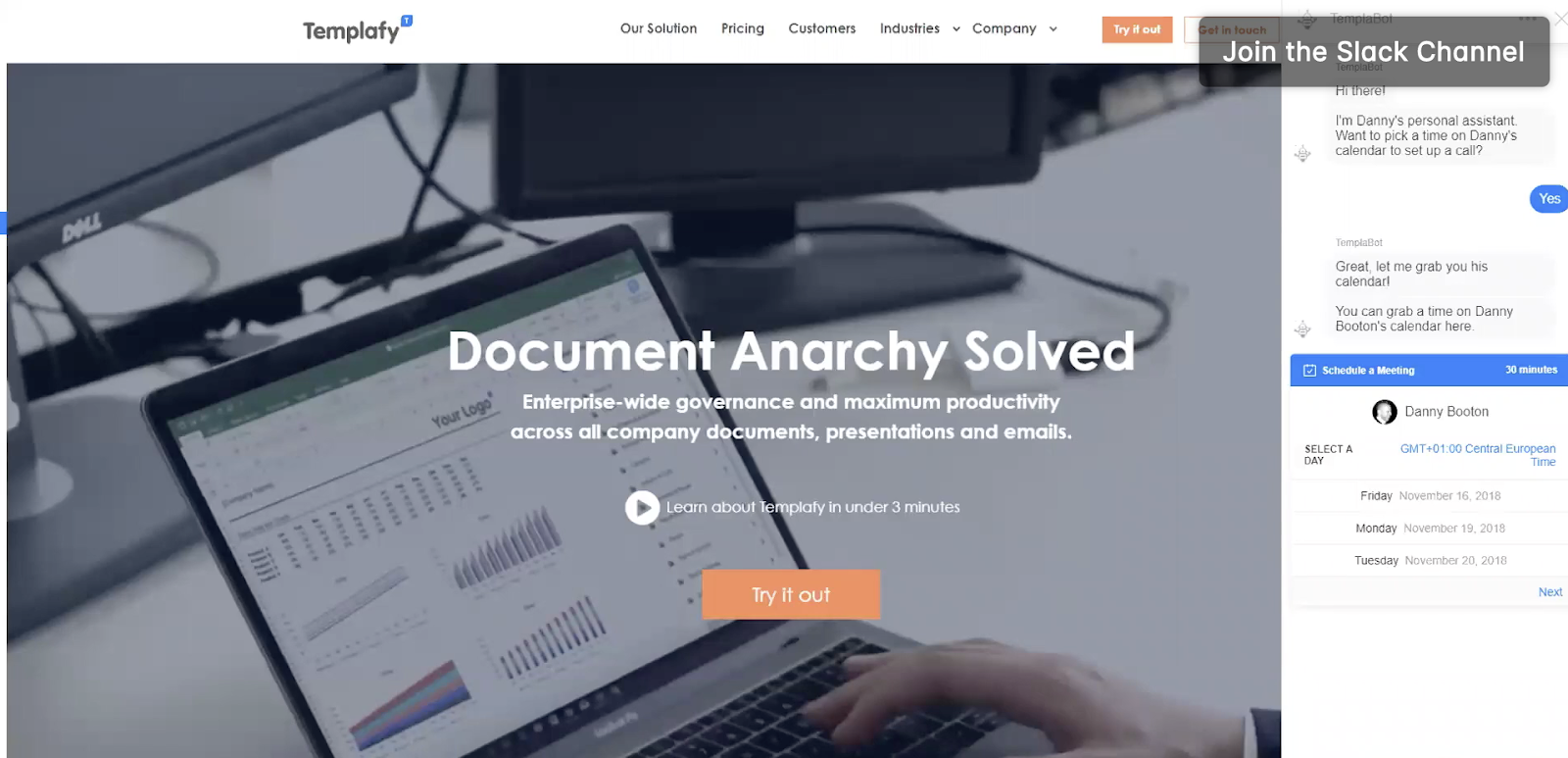
Step #6: Link it all together
Lastly, I used Zapier back in the day to tie it all together. You can tie it together if you use HubSpot or others but Zapier is definitely my go-to tool for doing certain things.

Output?
The question is, what came out of this? Some really, really cool stuff.
Responses
Let's look at the responses themselves.
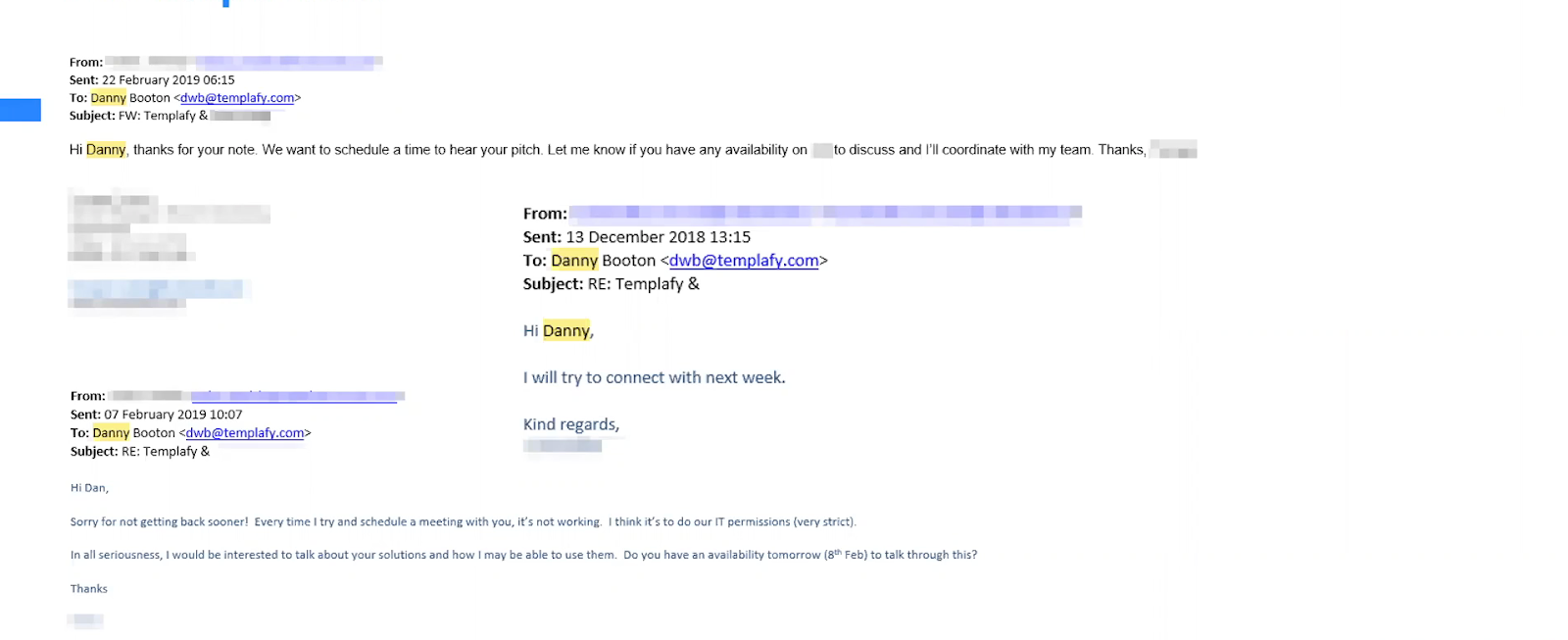
This was from automated generated emails that there was no touch from and the person responding back did not feel that these were automated at all.
People booking demo’s themselves
Secondly, and this is where I had a bit of a eureka moment, people would come into the Drift bots and they would book themselves in.
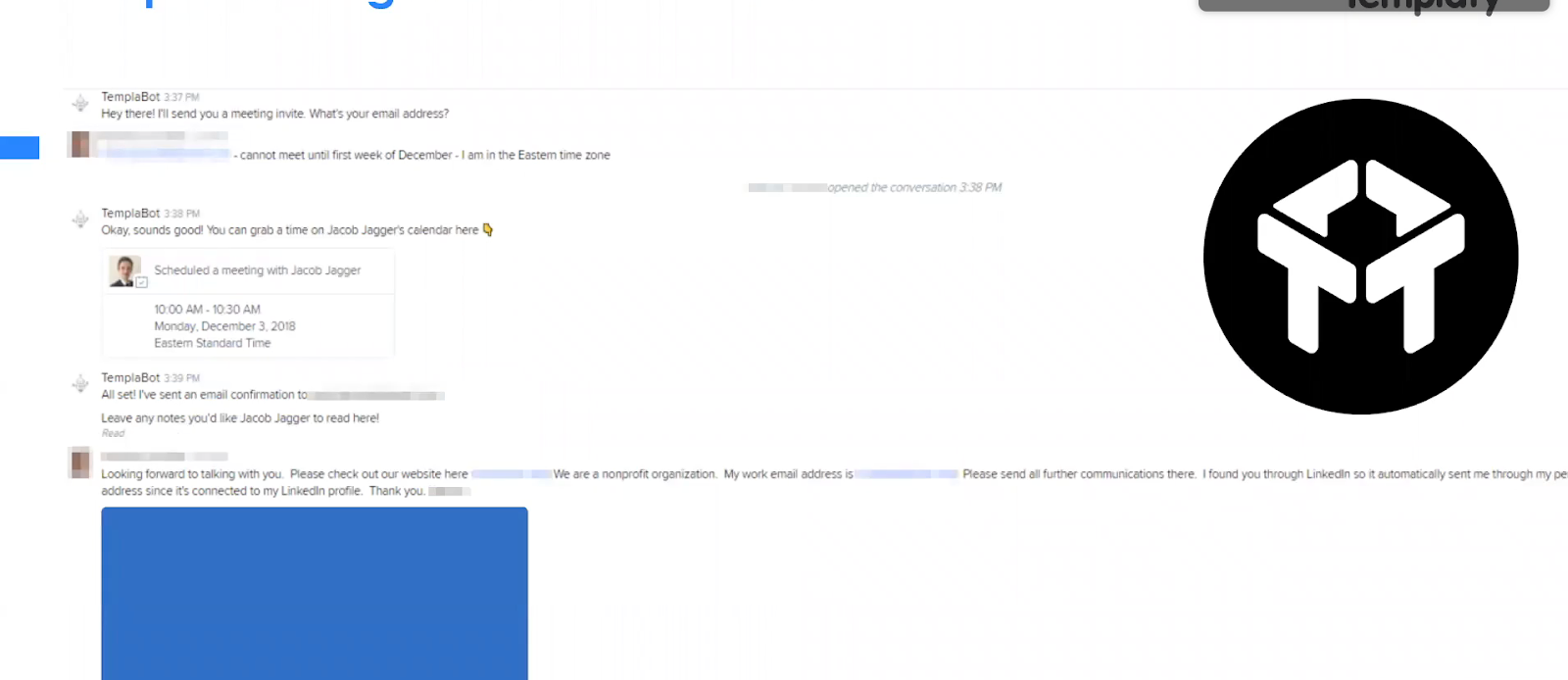
When you get to that point, you feel like a little mastermind, like the smartest person in the room. It's really powerful.

What happened?
Looking at the video data
There was a high play rate on the video. Based on 23, our video platform, we could actually see people watching these videos. They're short, but they were watching it all.

It's really awesome.
Results
Lastly, did this work in terms of the things that mattered? In terms of metrics?
Oh, yes. We had a 150% increase in booked meetings from LinkedIn and we had a 43% drop in cost per opportunity after.
Also by moving our activities to lead forms, which was the whole idea initially, that alone decreased our cost per qualified lead by 55%.
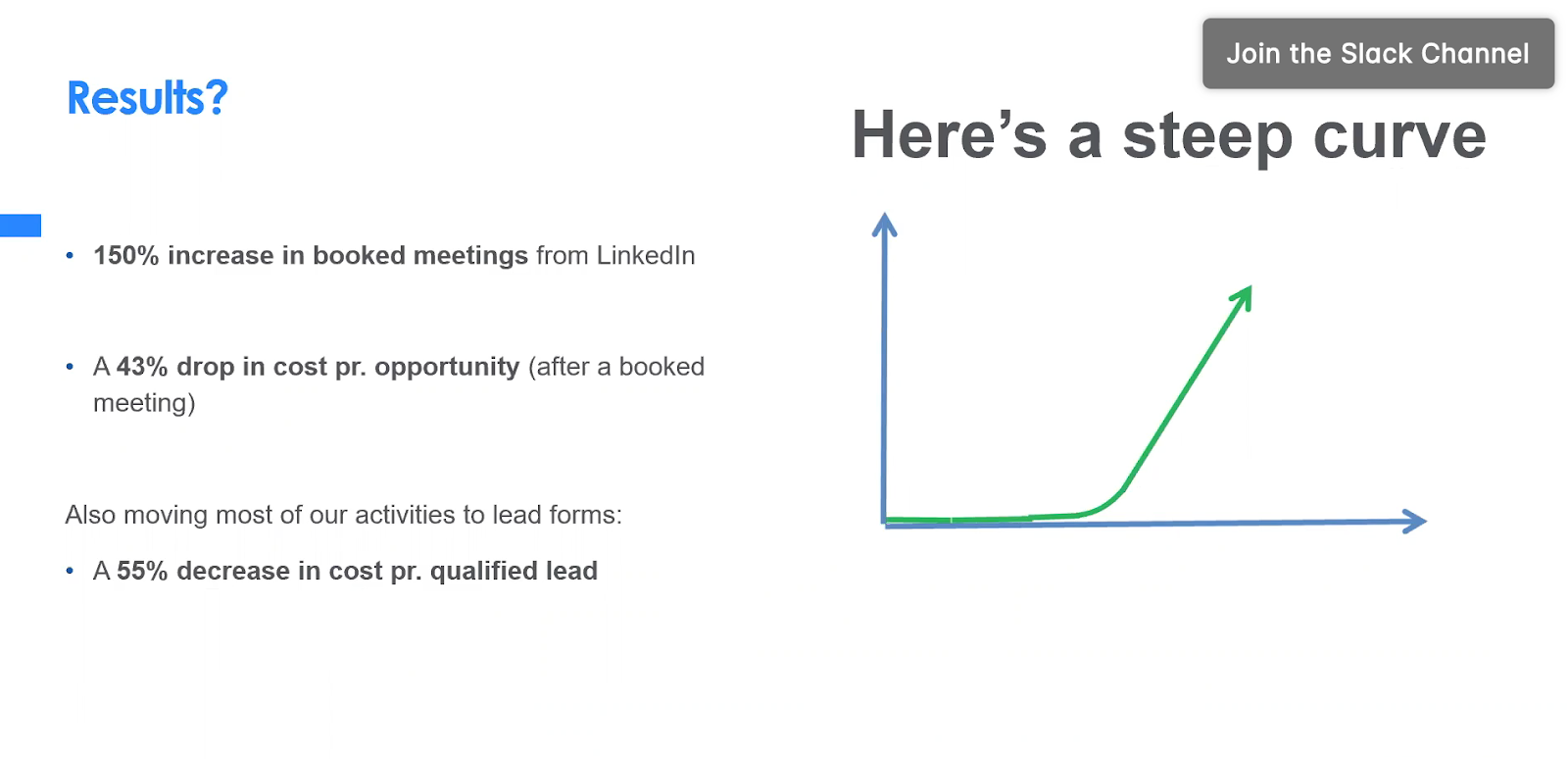
So yes, this was a really good case and it was a case of saying, how do we make this work for us while at the same time focusing on the metrics that actually matter to us?
Lightning round
This is more like some of the things that I wish someone would have told me earlier.
1. Do things that don’t scale
First of all, this is so cliche and I hate to do this, but it actually is really true. Do things that don't scale. What do you mean by that? Find things that work before you think about the scalability of these things.
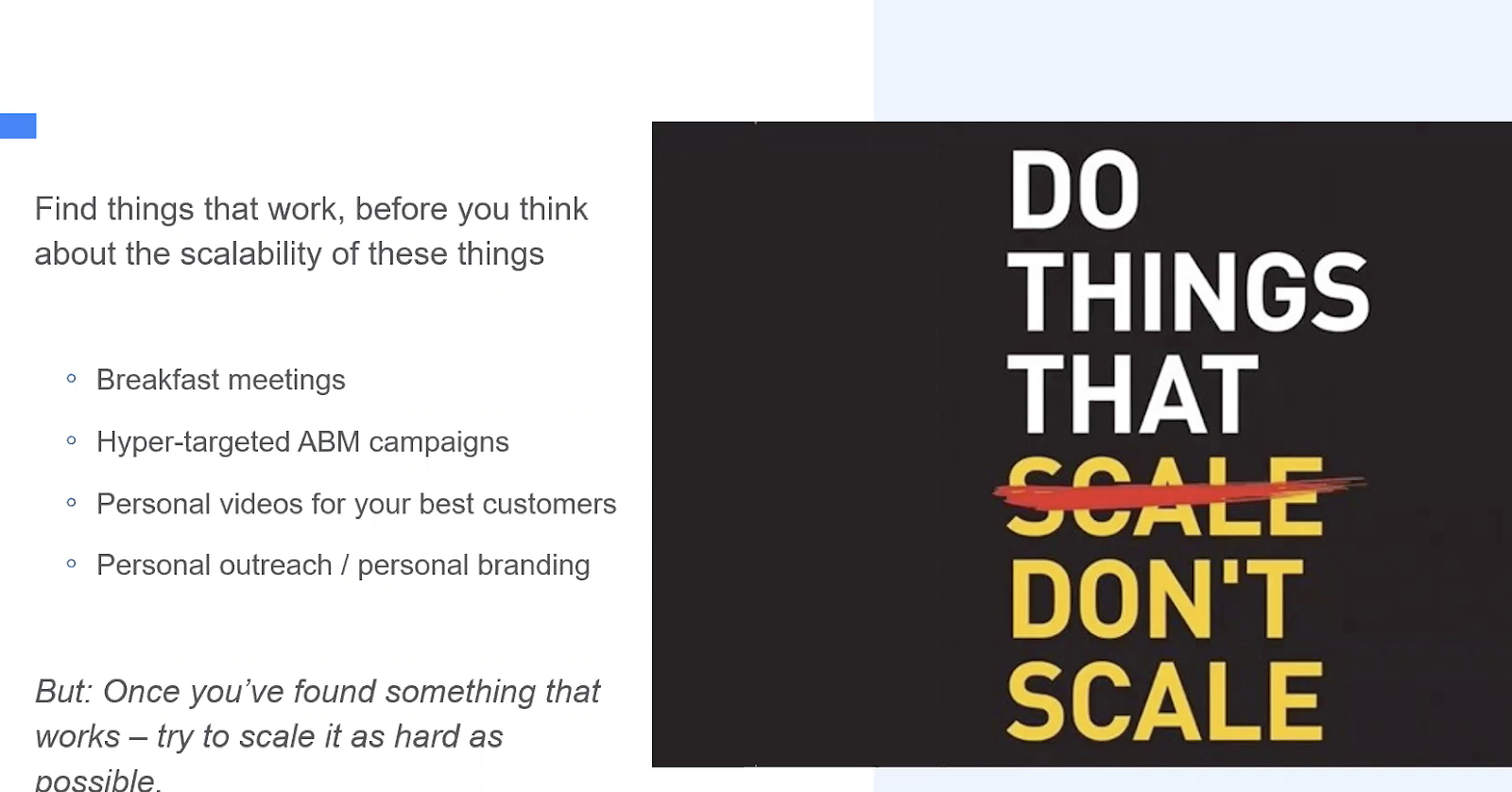
Do you want to have breakfast meetings where you invite 10 potential customers?
- Do you want hyper-targeted ABM campaigns?
- Personal videos for your best customers?
- Maybe do personal outreach or personal branding?
Do these things scale onto your organization where your 500/1000/500,000 people?
Probably not but that's not the point. Initially, you just want to gain traction, you just want to find things that work, then keep iterating, and sometimes you find a good idea, like the personal videos for your best customers.
That was not supposed to be scalable, but we made it scalable, and sometimes you just stumble upon the scalability.
Most importantly, once you find something that works, then you want to push it hard. Push it hard and keep pushing on it if you find something that works.
Things only last for a certain amount of time, this whole lead gen form idea I'm showing you things have changed a lot since I did that the first time. It's just a case of saying these things change all the time.
When you find something that works, do not let go of it.
2. Data is king, your gut is the queen
A bit of a controversial statement from me. My point is simple. If you have good enough data, then you will always trust data and I will always trust data to help me inform my decision. But sometimes there comes a point where data is not enough.
Data comes in and says, "Hey, Casper, I can see that the red and the green button are performing at basically the same level of performance". Then your gut is up to tell you "Okay, what do I want to invest in? What do I believe in?" That's the simple case.
But sometimes it will also be like, "Hey, I can see our Google Ads is not performing. Is that a general picture of Google ads? Or is it just because we haven't optimized it accordingly?" That is your gut feeling that can tell you if you're not doing a proper job.
In our case, that was actually the case where we had data that supported the idea that Google Ads was maybe not the thing we should invest in. But actually, I was more like, "Guys, I'm not sure we're doing it well enough. We're not good enough at this yet. So let's take a step back and make sure we're doing this properly".
And I was really, really right.
3. The playing field
The playing field is quite simple - 90% of all marketing budgets in the digital space goes to either of these two money grabbers - Facebook with Whatsapp, messenger, Instagram, so forth, or Google with YouTube, Google ads, Gmail.

Those two guys grab around 90% of the marketing spend. That's a lot. What is my point with this?
So what?
Lack of diversity = high-risk marketing profile
First of all, if you do the same, let's say you invest a lot on Facebook, and in Google, they’re the only platforms you're operating with. You have what I call a lack of diversity and you have what I also call a high-risk marketing profile.
The point of this is, let's say tomorrow Facebook decides to raise their prices threefold. You say, "Okay, I'll just move my stuff over to Google". But if you've been on Google in the last four years or last 10 years, for that matter, or on Facebook, then you are fully aware that those platforms are not getting cheaper.
They're not getting cheaper because there are more and more people using them, more people know how to use them and they are tapping these cash cows, they are not stupid.
If that happens suddenly, what do you do? You can’t move to other platforms because you've invested so heavily on these platforms. What you want to do is get to a point where you can quickly shift your budget from one channel to another.
Untapped potential
There's so much untapped potential out there. There's so much and people are not seeing it for what it is.
Did you know, for example, that Quora is just as big in terms of traffic as Twitter? Trust me, your social media person or part of the organization typically probably focuses on Twitter exclusively, together with Facebook and LinkedIn maybe. But Quora has a lot of potential - Reddit almost the same amount of traffic.
There's Tik Tok - everyone talks about Tik Tok but no one's doing stuff on Tik Tok. Yes, they just opened up their ad platform but you can do stuff organically there's so much potential. Pinterest - if I was in B2C e-commerce Lord I would use Pinterest so much, so much potential.
Tumblr, Snapchat, review platforms, there's a lot of potential and people are not using it. Be aware of that - you can find gold here.
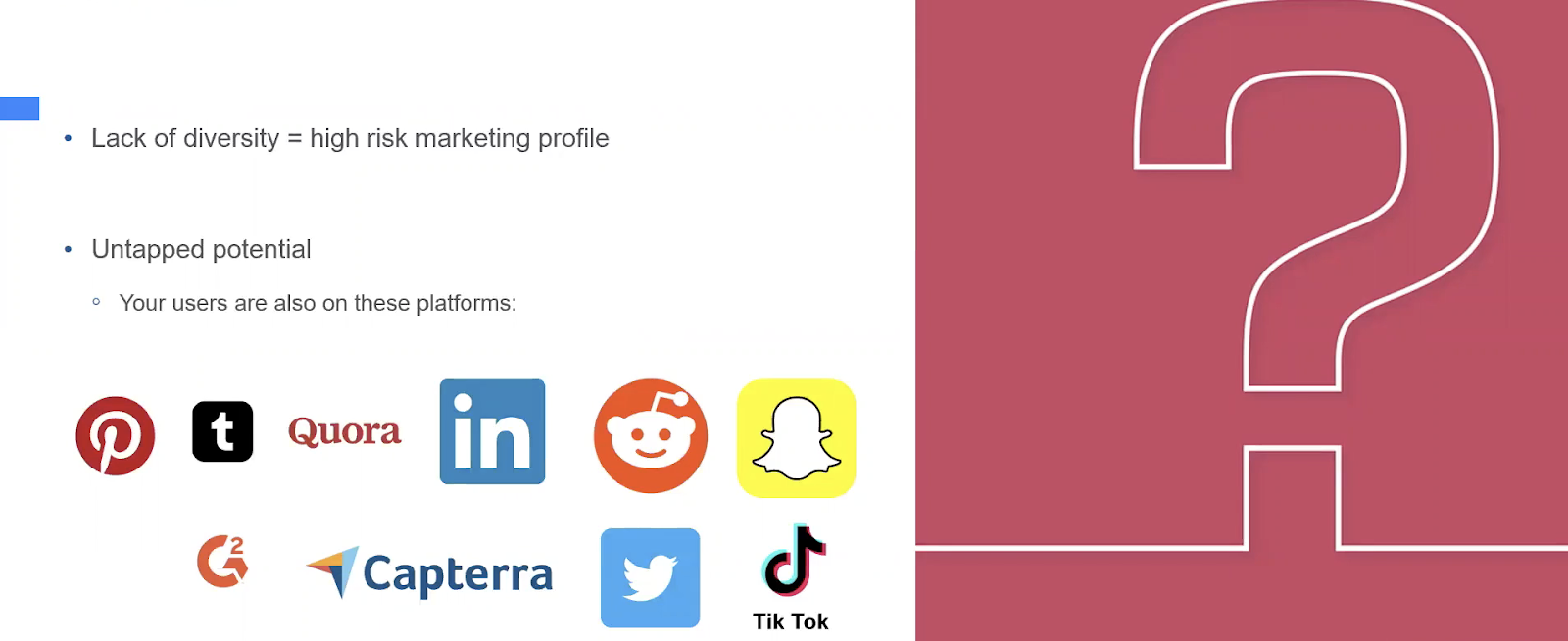
4. Strategy eats growth hacks for breakfast
This is my most important part - strategy eats growth hacks for breakfast. If your strategy around your product and your product offering is not good, then you can be the best marketeer or best growth hacker in the world, it's probably not going to work.
Hint: there is no silver bullet
A lot of people try to book me in all the time and talk to me and they expect to get this silver bullet. There is no silver bullet. There's hard work and that's the only thing that gets you there.
Growth hacking is a lot more than having a growth mindset. It's a lot more about the process. It's about finding something that works, what we call a growth lever. This works, here we do growth, and then using it because a growth lever is something where you compound growth - compound a good thing over time.
So it's a lot more about the process and understanding that it's about process is the first step in becoming a good growth hacker or a good head of growth.
Thank you.



